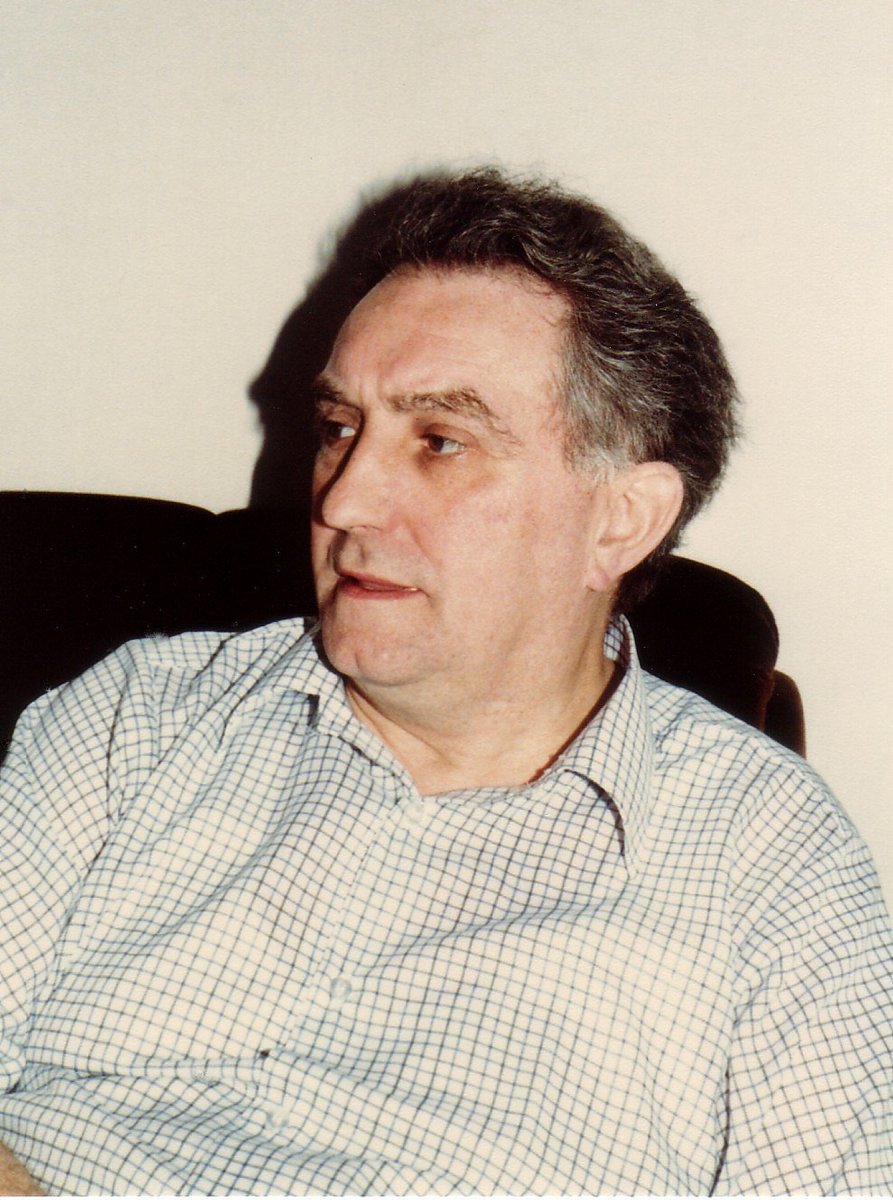 Dedicated to Mac HARTLEY [1924-1999]
Dedicated to Mac HARTLEY [1924-1999]
hartleyfamily.uk - The Life and Times of MacH
 Dedicated to Mac HARTLEY [1924-1999]
Dedicated to Mac HARTLEY [1924-1999]
![]() by William Hartley, one of Mac's sons.
by William Hartley, one of Mac's sons.
 Air Mechanic-Armourer, Squadron 831 Fleet Air Arm: May 1942
to April 1946
Air Mechanic-Armourer, Squadron 831 Fleet Air Arm: May 1942
to April 1946 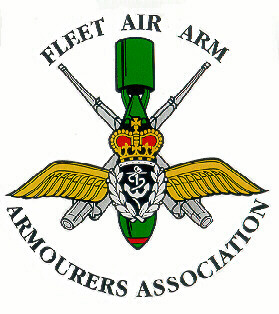
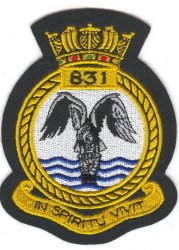
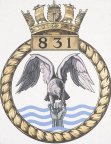
After wandering down to the local Naval Recruitment Office early in 1942, aged just 18, Mac volunteered to go to war with the Fleet Air Arm. He had an interview, a brief medical ... he was in for four years. A letter and travel warrant from the Admiralty told him to report to basic field 'discipline' training at HMS Duke ... to turn a boy into a ruthless fighter !
The
Atlantic Campaign
Map showing the places Mac was based between May 1942 and June
1944
View MacH
in a larger map
The
Atlantic Campaign Map
Training and Bases stationed: HMS Duke [Greater Malvern, Worcestershire], HMS Medina [near Ryde, Isle of Wight], HMS Daedalus [Lee on Solent, Portsmouth], HMS Merlin [Donibristle near Cowdenbeath, Scotland], HMS Heron [Yeovilton, Somerset], HMS Waxwing [near Dunfermline, Scotland], HMS Landrail [Machrihanish, Argyll and Bute, Scotland], HMS Shrike [Maydown, Co.Londonderry, North of Ireland], HMS Sparrowhawk [Hatston, Scapa Flow, Orkneys, Scotland], HMS Jackdaw [Operational Training near Crail, Fife, Scotland], HMS Excellent [Whale Island, Portsmouth]
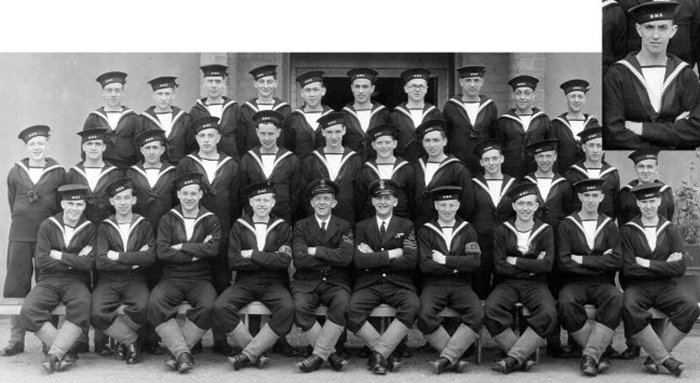 HMS Duke, Great Malvern [June 1942]
HMS Duke, Great Malvern [June 1942]
HMS
Duke was at Great Malvern Worcestershire. Consisted of row upon row
of one storey buildings. Sleeping quarters were two-tier metal bunks, blankets,
no sheets. For twelve dozen raw recruits, basic training began in seamanship,
rifle drill, and naval discipline, spread over five weeks.
The first morning, AMOs were kitted out at the clothing store [the Slops] with
number two and three rigs, basic serge naval uniform complete with drop-front
'Jack Tar' trousers, a hat, two pair of overalls, two sets of duck suits, a
heavy navy overcoat, an oilskin coat, a belt, drawers [pants], two pair of boots
with gaiters [no shoes], towels, various brushes, a large pocket knife ['pusser's
dagger'] with marline spike for cutting/splicing ropes, soap, a big canvas kitbag
and a hammock. And the 'Admiralty Manual of Seamanship Volume One'. Also a 'ditty
box' for personal possessions, and a 'housewife' consisting of a long piece
of blue material with sewing needles, thread, and some wool. You'd be given
a large piece of brown paper and a piece of string to wrap your civilian clothes
in; you'd address the parcel to post them home. You'd be given a gas mask contained
in a cardboard box within a green satchel, carried over your shoulder at all
times during the whole war, not that it was ever needed. You weren't issued
with a personal knife, fork, or spoon [Irons] or mug ... Irons were in a large
tray and as you entered the dining hall you picked your own utensils and mug.
All other ships, and shore bases would supply you with your own. All this routine
you would come to expect every time you joined another ship or shore base. You
then struggled back to your mess hut carrying your kit. No lunch. You'd spend
the afternoon marking your name on your kit. Lending and borrowing wasn't allowed
so everything had to be marked. If someone else's property was found in your
kit it was easily identified and it was assumed you'd stolen it.
Later there was a welcome bugle call 'Hands to Dinner'.
Next morning
came a visit to Sickbay for a full medical, then tetanus, toxoid and typhoid
inoculations and vaccination jabs.
"Strip off, gear on the bench, then get fell in over here ...". Recruits
were standing in line, stark naked, as the medical officer closely examined
every intimate detail, silently passing by, both front and rear. Then came individual
tests; eye and ear tests, a mouth inspection, chest examination and a blood
pressure test. Lastly the jabs. Plenty fainted when they received theirs.
Everyone was given a smart, short haircut. You'd be issued with station card
with your watch [port or starboard]. Also a green covered pass book with your
photograph, and medical history of jabs.
Each morning after that you'd look at a large display board where all the different
orders were shown. If it was raining, oilskins would be worn, other times, number
ones, navy uniform, and a heavy coat. You didn't feel the least bit cold. The
navy uniform was so tight, you had to help each other in and out of jumpers,
until they slackened off. In the morning you'd be woken by a marine bugler and
you fell in for divisions, all lined up for inspection by an officer who'd be
standing there with a heavy watchkeepers coat [used for the long lonely hours
of watchkeeping on board ships, in the cold of the Atlantic, or the Russian
convoys]. You marched up and down the parade ground - 'Square Bashing' - as
the Royal Marine band played tunes like ‘Hearts of Oak’, ‘A Life on the Ocean
Waves’ and, 'Rule Britannia’, all marching tunes of the Royal Navy. You were
finally dismissed.
Eventually you'd be given WWI short Lee Enfield rifles for practicing those
various routines. Very welcome in the Navy was, ‘Stand easy’ at 2200 hours,
when they piped you to stand down.
You'd learn to swim at the local Malvern swimming baths ... then with duck suits
on, you swam two lengths. Each night before tea you'd run three miles to keep
fit.
Finally, you'd finished the discipline course. In the mess deck everyone would
be singing "Oh we had to join, Oh we had to join, Old Churchill’s Navy,
Ten bob a week, F**k all to eat, Big black boots and blisters on your feet,
We had to join ..."
HMS Medina at Puckpool Park near Ryde, Isle of Wight.
Medina was
situated in Puckpool Park, Ryde, Isle of Wight, a former Warners Holiday Camp
taken over by the Navy in 1940. Puckpool House was taken over by Captain Herbert
Edwards. There were row upon row of chalets which slept four on two-tier bunks.
Where the putting green and swings are nowadays was the Quarterdeck where all
the marching took place. There was a gun emplacement on the Seaview Esplanade,
manned by sailors who took over the front room of Beach Cottage. The old Victorian
gun emplacements provided antiaircraft gun positions and were also used as a
training area. In the centre of the camp there was a large dining hall and on
one wall a huge glass framed roll of honour to officers and ratings lost in
the present conflict. A boom had been placed in Spithead, stretching from The
Duver at Seaview on the Isle of Wight right across to Southsea. Its purpose
was to keep out German submarines from entering Portsmouth Harbour and the naval
vessels there. A gap was left in the barrier to enable our ships to enter Spithead
Waters [or Portsmouth] and this was guarded by a small naval vessel at each
end of the gap.
After parade at 0655 hours you'd march, parade, breakfast, parade, march, go
to classes [aircraft recognition], parade, march, maths classes in decimals
and algebra, parade, then it was time for dinner; steak and kidney pudding and
potatoes, stewed fruit and custard and a mug of tea. Next, parade, more classes
[this time navigation], tea, parade ... then it was your turn for 'night duties';
the rest would 'go ashore', or 'stay onboard' ... a shilling [5p] to get in
a local music hall was half a day's pay. You could just manage fish n chips
and a beer, too ! On board, you could drink in the canteen, play snooker in
a smoke-filled hall or just read your 'Manual'' and learn 'How to tie knots'
and 'How to lower the ships lifeboat from it’s davits'. Popular drinking games
included 'Liars Dice' and 'Cardinal Paf' or 'Puff' as it was called.
A drink ashore was something men looked forward to. The rumours persisted that canteen cooks added potassium bromide to Naval drinks as a sedative ... you were led to believe it 'reduced your sexual urges' but there was little proof of that !
Daedalus
'The Stone Frigate' 1942 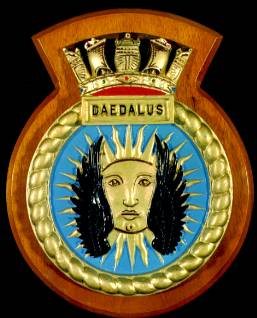 Fleet Air Arm HQ, Lee on Solent
Fleet Air Arm HQ, Lee on Solent
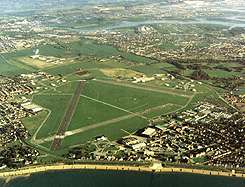

HMS Daedalus at Lee on Solent, Portsmouth. It was the start
of a five months 'technical' course. In the mornings, 0630 hours sharp, an officer
would come into our hut, rattle a stick against the side of the iron beds and
shout at all dozen men “Wakey, wakey, rise and shine, shake a leg, wakey, wakey,
rise and shine”. Inside, the wartime blackout over the windows kept the hut
in pitch dark but outside it was bright morning sunshine. You leapt from your
bed to be first in the queue to wash, shave, then dress and fold your bed neatly
before the 0655 parade. Next you'd march to the hangars with a bugle band in
front. Issued with an exercise book and pencil, you'd make notes as an RAF instructor
taught you all about the theory of flight, how a plane flys, by weight, thurst,
drag, and lift. All about hydraulics, aerodynamics, angle of incidence, and
dihedral angles. Mainplanes, ailerons, stabilisers, flaps, slats, landing wires,
flying wires, non return valves. How to splice wire ropes, and all about high
tensile nuts and bolts.
AMO Ratings eventually 'went ashore' on the halfpenny Gosport ferry to get fitted
for their smart black serge 'number one' suits from Naval outfitters 'Gieves
of Portsmouth'. From now onwards, when 'going ashore', you looked like proper
sailors. "And remember men, all the nice girls love a sailor ..."
Occasionally, some sailors were troubled with a rash which affected the 'privates'
with a terrible itch. You'd report to sickbay and join the long queue. Eventually
a WAAF nurse would give you a piece of paper with some greasy looking stuff
on top and tell you to go behind the screens and rub it all over the affected
parts. You'd drop your trousers and rub between the legs, come out and throw
the piece of paper in the bin. As you stepped outside the sickbay, as soon as
you hit the outside air, you'd let out a howl as if your 'privates' were on
fire ! You'd run down to your hut with your legs wide open and the WAAF nurses
would be standing at the door roaring an laughing.
The course is finished and you've passed out as an Air Mechanic Ordinary Rating, or 'Erks' as officers called them. You leave tomorrow for work at another base.
HMS Merlin [Donibristle base at Dalgety Bay, Cowdenbeath, Fife, Scotland] HQ and Repair Yard
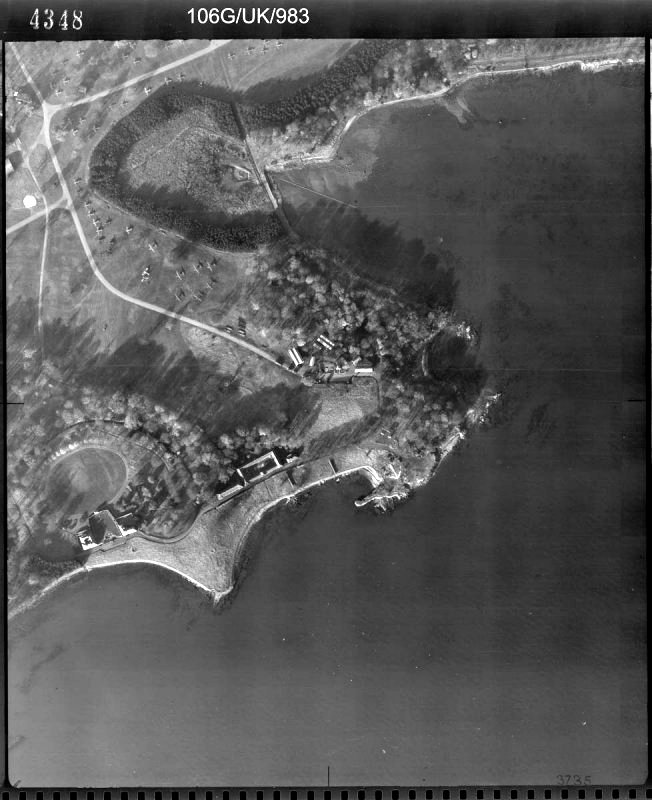 [Copyright
RCAHMS]
[Copyright
RCAHMS]
 Mac sitting on an aircraft wing. HMS Heron [1943]
Mac sitting on an aircraft wing. HMS Heron [1943]
HMS Heron, RNAS Yeovilton, Somerset
The Fleet Air Arm Museum is located 7 miles north of Yeovil, and 40 miles south of Bristol. It has an extensive collection of military and civilian aircraft, as well as models of Royal Navy ships, especially aircraft carriers. Some of the museum has interactive displays. It is located by RNAS Yeovilton, and the museum has viewing areas where visitors can watch military aircraft [especially helicopters] take off ...
HMS Waxwing [Townhill nr. Dunfermline, Fife, Scotland]. This was just a transit camp. You're granted seven days leave. There were a large number of nissen huts, with one large one for the dining hall. The huts had the usual iron stove in the centre to provide heat. A gunnery instructor who had done his training at HMS Medina, "the greatest gunnery school in the world" he says, teaches weoponry drill and all about stoppages when a machine gun jams, and how to rectify it. You're now familar with all the different pipes; up spirits, stand easy, men under punishment, cooks to the galley, and liberty men fall in. In Scotland, breakfast would consist of porridge and kippers rather than egg and bacon. The kippers were like pieces of leather. Rather than eat them, ratings would throw them at each other across the canteen.
HMS Jackdaw [Operational Training, Crail, Fife, Scotland]
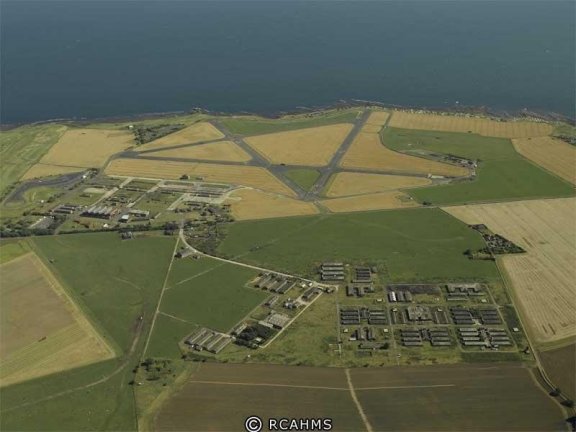 HMS Jackdaw from the air
HMS Jackdaw from the air  1940's aerial photo.[Copyright RCAHMS]
1940's aerial photo.[Copyright RCAHMS]
 hangars
at Crail
hangars
at Crail 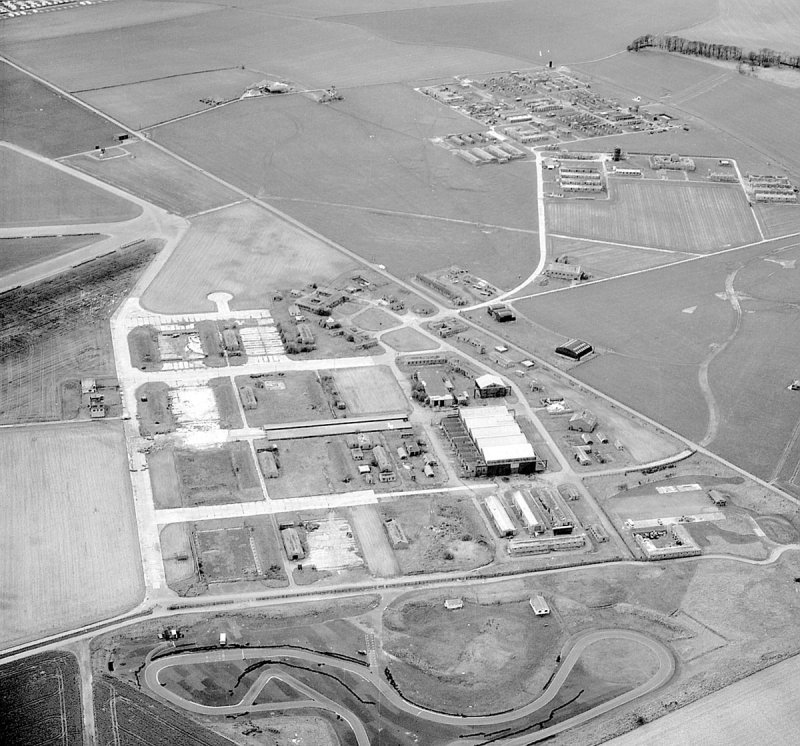
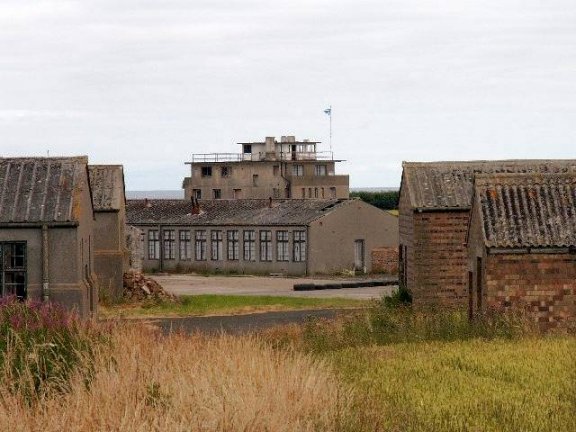
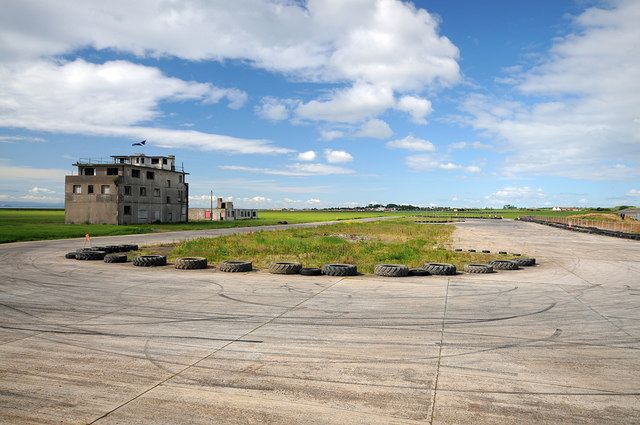 buildings at HMS Jackdaw, today.
buildings at HMS Jackdaw, today.
Practiced loading and dropping torpedos [called 'fish']. At £2000 each, torpedos were carefully looked after and used sparingly. They were 17 feet in length, 18 inches in diameter and were dropped from Barracudas at an altitude of just 100 feet.
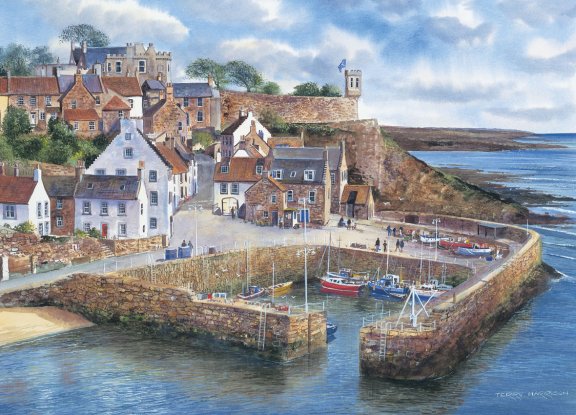 Crail Harbour Video of Crail Harbour, today.
Crail Harbour Video of Crail Harbour, today.
View
Larger Map
HMS Landrail [Machrihanish,
Argyll and Bute, Scotland].
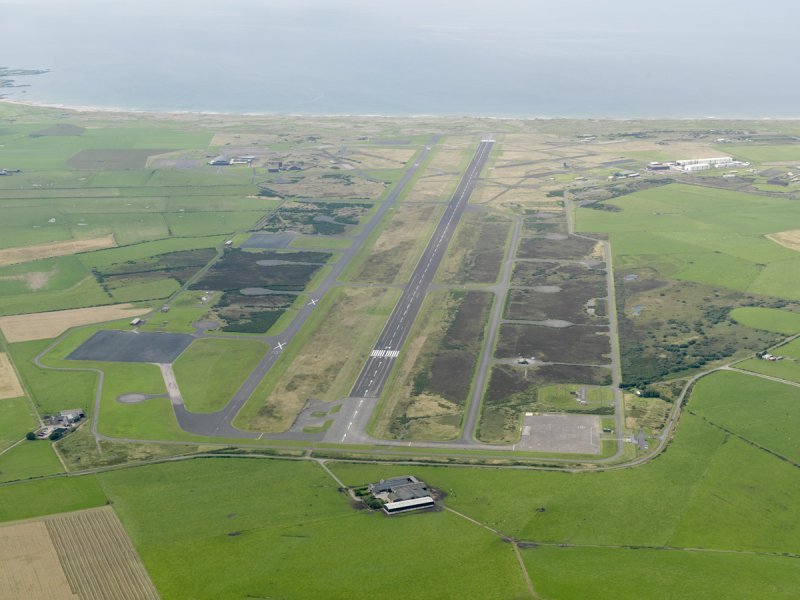
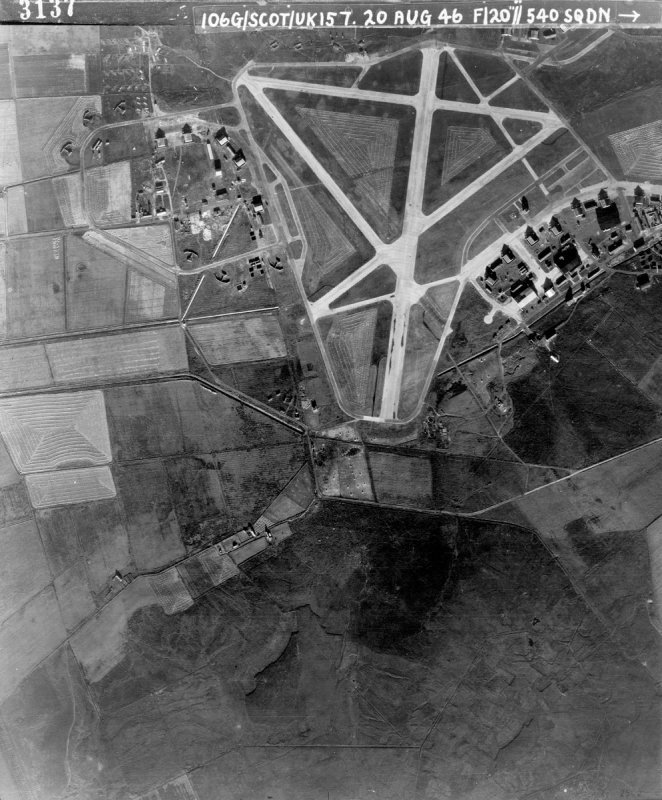 [Copyright RCAHMS]
You have a draft chit to HMS Landrail, at that time the biggest airfield in
the UK. Your quarters nicknamed 'Nissen City' [in the far corner of the airfield]
are your billet for your stay here. A short distance away you can see the village
of Ugadale with it’s small pub. At Landrail there were daily inspections to
see that aircraft were airworthy. Pilots would practice landings on the deck
of the carrier, difficult when the ship was pitching and rolling at 30 knots.
Pilots were aptly called 'Brylcreem Boys' as they were always impeccably dressed
and groomed and wore lots of after-shave.
[Copyright RCAHMS]
You have a draft chit to HMS Landrail, at that time the biggest airfield in
the UK. Your quarters nicknamed 'Nissen City' [in the far corner of the airfield]
are your billet for your stay here. A short distance away you can see the village
of Ugadale with it’s small pub. At Landrail there were daily inspections to
see that aircraft were airworthy. Pilots would practice landings on the deck
of the carrier, difficult when the ship was pitching and rolling at 30 knots.
Pilots were aptly called 'Brylcreem Boys' as they were always impeccably dressed
and groomed and wore lots of after-shave.
Some nights a troopcarrier would convey you up to the main camp to see a film
in the gym or go to the canteen for a pint, and join in the sing songs, with
the seamen, stokers, and torpedo men. The canteen was always full, noisy, men
running back and forwards to the bar, and shouting across the room to their
mates. The songs were sung with a sort of defiance against authority and discipline,
and sung very loud. There was a comradeship in the navy you wouldn't find anywhere
else. Through the songs you could be yourself.
Next, another draft chit back to another base, for a ship or overseas draft. Eventually you're told to report for a medical and to be issued with tropical gear. At sickbay you're given more jabs [including cholera]. You'd be on your way to Liverpool to board ship for sea.
HMS Shrike [Maydown, Co.Londonderry, North of Ireland], satellite to RAF Eglinton/Royal Navy 1-5-1943
HMS Sparrowhawk [Hatston, Kirkwall/Scapa Flow, Orkneys, Scotland]
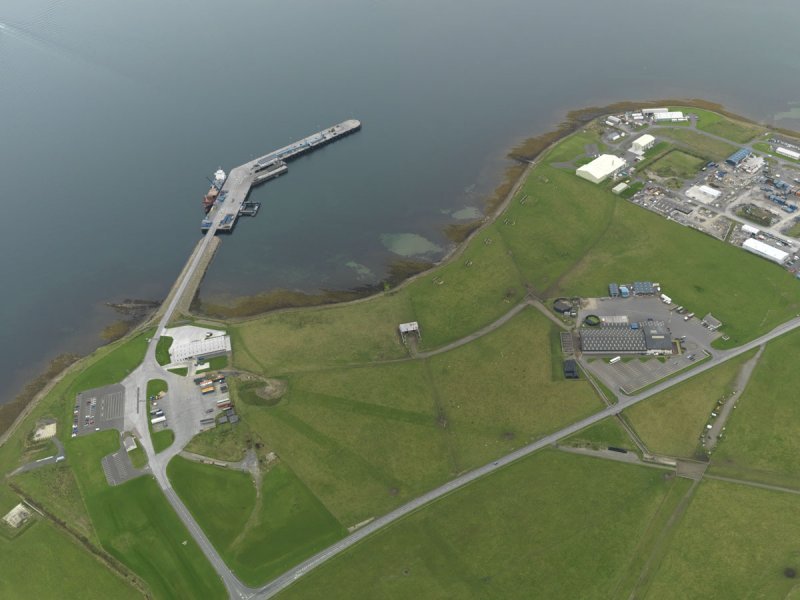
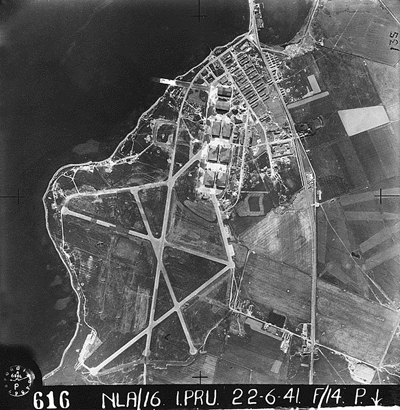
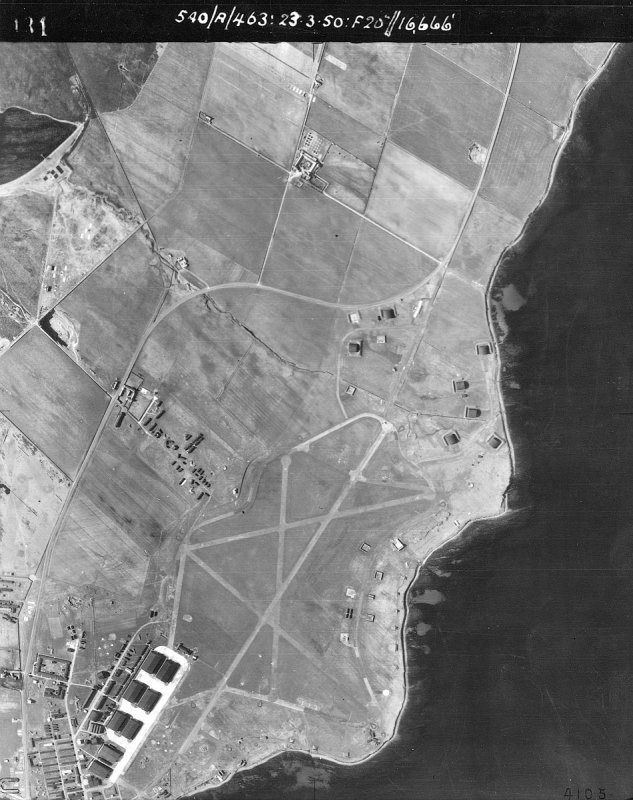 [Copyright RCAHMS] One of the main Fleet Air Arm Air Stations
of WW2 commissioned in 1939. Its value lay in being far from enemy attacks and
being close to the Home Fleet at Scapa Flow.
[Copyright RCAHMS] One of the main Fleet Air Arm Air Stations
of WW2 commissioned in 1939. Its value lay in being far from enemy attacks and
being close to the Home Fleet at Scapa Flow.
British
Atlantic Fleet: HMS Victorious 1944 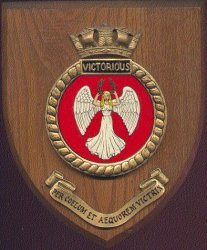


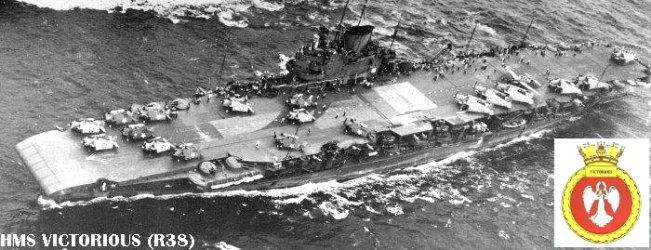
Built
by Vickers-Armstrong, Walker-Upon-Tyne, HMS Victorious was laid down 4th May
1937, launched 14th September 1939. 27th January 1941, whilst still in Walker
Yard fitting out, she was narrowly missed by 2 bombs during a German air raid.
HMS Victorious joined the Home Fleet on commissioning 26th May 1941. Just nine
days later, despite the ship being incomplete and her aircrews inexperienced,
Victorious attacked the mighty German battleship Bismarck; she succeeded in
putting three torpedos into the battleship's midship section, which opened up
a fuel tank. This was, however, insufficient to stop the battleship. After the
later sinking of the Bismarck, HMS Victorious continued to operate with the
Home Fleet. 23rd July 1941 she sailed from Scapa Flow escorted by heavy cruisers
Suffolk and Devonshire and 6 destroyers for an attack on German bases at Kirkenes
and Petsamo, North Norway. The task force was spotted by a German scout plane
on 30th July and the attackers received a hot welcome, sustaining heavy losses.
Her Fairey Albacore aircraft were subsequently involved in an attack on the
German battleship Tirpitz in March 1942. 9th March 1942, Victorious launched
12 Albacore torpedo bombers against the Tirpitz at her anchorage. 2 planes were
shot down by the defences and no damage was done to the batlleship.
HMS Victorious provided cover for Russian convoys PQ-15 and PQ-17 in May and
June 1942 respectively. HMS Victorious left the Clyde with the Operation "Pedestal"
convoy on 3 August 1942; she left the "Pedestal" convoy on the 10th of August
and took part in the North African landings in November 1942, also served on
Malta relief runs.
21st November 1942, the German submarine U-517 was sunk in the North Atlantic
south-west of Ireland, 1 dead and 52 survivors, in position 46º16'N, 17º09'W,
by depth charges from Albacore aircraft [Sqdn 817/I] of the British carrier
HMS Victorious. [U-517: Kapitänleutnant Paul Härtwig; 8 ships sunk for a
total of 26,383 GRT; Canadian warship HMCS Charlottetown [K 244] sunk [her Commander
and five ratings were lost and three ratings later died of wounds]. Paul Härtwig
spent the time from November 1942 to the end of the war in Allied captivity.
After the war Härtwig joined the newly formed Bundesmarine and during the 1970's
rose to the rank of Vice Admiral.]
Loaned to the US fleet 20 November 1942 and refitted at Norfolk, served with
the US Pacific Fleet [Pearl Harbour] February 1943 to August 1943. HMS Victorious
was refitted at Norfolk Navy Yard USA, during the winter of 1942-43, after which
she was loaned to the US Pacific Fleet until being replaced by the new USS Essex.
Despite its massive industrial muscle, the United States still found itself
short of carriers in the Pacific, the only American carrier available in the
South Pacific was USS Saratoga. HMS Victorious sailed to Pearl Harbor to join
USS Saratoga's Battle Group, Task Force 14. She arrived and took up duties under
Task Force 14 in the the Southwest Pacific on 17th May 1943. She embarked US
aircraft and aircrew, and with the Saratoga swept the Solomon Islands. In May-June
1943, at Noumea, New Caledonia, the light cruiser USS San Diego joined USS Saratoga
and HMS Victorious in support of the invasion of Munda, New Georgia, and of
Bougainville. During this period Victorious operated 60 British and American
Wildcat fighters for air cover. The two carriers sailed on 27th June, the carriers
took up position and in the next few days put up 600 sorties against little
opposition. The aircraft were reassigned to their parent carriers on 24th July,
and the force reached Noumea the next day.
Resuming
her former name, HMS Victorious returned to the Home Fleet at Scapa Flow in
late 1943
Commanding Officers: Captain Henry Cecil BOVELL, RN 15th October 1940 - 23rd November 1942 CBE 14th October 1941 Captain Lachlan Donald MACKINTOSH, DSC, RN 23rd November 1942 - 1st November 1943 DSO awarded on 28th May 1943 A/Captain Richard Cyril Vesey ROSS, DSO, RN 1st November 1943 - 8th December 1943.
November 1943 Squadron 831 joined No 52 TBR Wing with Squadron 829 at Machrihanish. Scotland. 'HMS Victorious' was refitted and renovated over winter 1943-1944, including the fitting of new Radar Scanners.
December 1943: HMS Victorious had a new Captain: Michael Maynard DENNY CB, ex HMS Kenya; CBE January 1944.
January 1944: Squadron 831 Commanding Officers: L/C V RANCE, RN [Jan 1944 to Feb 1944]; L/C(A) D BROOKS, DSC, RNVR [Feb 1944 to May 1944]; L/C(A) JL FISHER, RNVR [May 1944 to Dec 1944]
Anti-shipping raid on the Norwegian coast with HMS Furious. Aircraft attacked a German convoy, sinking the transport Blaufuchs [ex Hans Leonhardt] and setting Sperrbrecher 181 on fire [the Sperrbrecher will sink at Stadlandet on 6th June from accumulation of damage].
HMS
Victorious underwent sea trials at Greenock in February 1944,
reaching in excess of 30 knots. Adjustments were made at a commercial shipyard
at Liverpool.
'HMS Victorious' undertook Gunnery Trials at HMS Shrike [Maydown, Co.Londonderry,
North of Ireland [Belfast Lough]] and Deck Landing Trials at HMS Landrail
[Machrihanish, Argyll and Bute, Scotland].
25th March - 26th March 1944: exercises at HMS Sparrowhawk [Hatston, Scapa Flow, Orkneys, Scotland]
 HMS Victorious carried Barracuda II strike-bomber aircraft
HMS Victorious carried Barracuda II strike-bomber aircraft 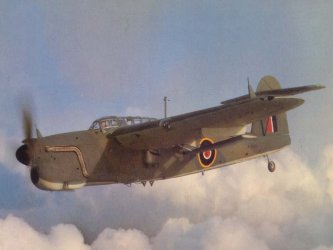 and fighter Corsairs [Vought Sikorksy F4U - Corsairs had their wing tips
clipped, 20cm being removed at the tips, to allow storage of the F4U on the
lower decks of British carriers].
and fighter Corsairs [Vought Sikorksy F4U - Corsairs had their wing tips
clipped, 20cm being removed at the tips, to allow storage of the F4U on the
lower decks of British carriers].
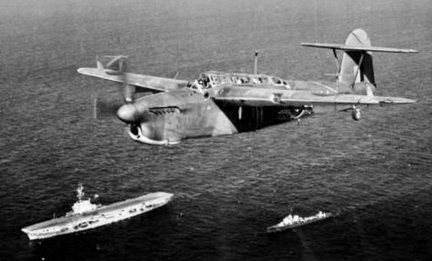 HMS
Victorious, with Barracuda flying overhead
HMS
Victorious, with Barracuda flying overhead
27th
March 1944: "The worst journey in the world".
'HMS Victorious' was assigned to distant cover Russian Convoy 'JW 58' in the North Atlantic. Her presence permitted a greater degree of protection against both air and submarine attack, and an inherent ability to refuel and rearm their aircraft represented a great improvement over the catapult-armed merchant [CAM] ships she replaced. Conceived as a temporary solution to the lack of sufficient air cover for convoys, CAM fighters required a great deal of courage on the part of the RAF and Fleet Air Arm pilots who manned them. When aboard their parent vessel as passengers they naturally shared the same hazards of surface raider and submarine attack, but the most dangerous element of their task remained dealing with airborne threats. There was no means of recovering a Hurricat after it was launched. Once the attackers had been driven off, or when his fuel began to run low, a pilot would have to ditch his aircraft in the sea as near the convoy as possible and hope for rescue.
The
Convoy left Loch Ewe and arrived at Kola Inlet on 4th April [50 ships]. Temperatures
of 24 degrees below zero !! Extra blankets issued. Russian convoys travelled
through the Arctic Circle towards the port of Murmansk, Russia. The Naval Base
was on the Kola Peninsula on the Norwegian/Russian border. The sun never set
there, so there was broad daylight even at midnight. Russians entertained the
Navy with white fish, cavier, salmon and carafes of Vodka. Despite a sense of
camaraderie, relations between British and Russian sailors were not always so
cordial. A genuine sense of comradeship born of shared difficulties and dangers
could often be marred by ideologically-centred suspicion and distrust, and on
occasion by simple lack of mutual understanding. British visitors to military
hospitals in Murmansk were often appalled at the squalid conditions which wounded
British seamen had to endure. The Russians for their part would resent such
an attitude from outsiders when their own people could expect no better. Despite
such issues, the working partnership between the two allies never broke down
...
Map showing routes of Arctic 'Russian Convoys' 1941-1945.
Sailors were met with extremely gruelling conditions as they
transported raw
materials, food, tanks, fighter planes
and ammunition to Russia. Convoys sailed from the western coast of Iceland and
followed a track north of the Jan Mayen and Bear Islands, to Kola Peninsular,
a journey which averaged fifteen days. On deck, officers wore duffel coats as
a primary protection against the cold, and all sailors wore fur-lined mittens
and heavy woollen socks, sometimes over their shoes and boots; the socks were
so thick, it was impossible to wear them inside anything other than boots which
were two sizes larger than the wearer's feet. Clearing ice from decks and off
vital equipment such as weapon mountings became a matter of near-constant routine,
for if left unchecked even the largest shipboard mechanisms such as gun turrets
could jam and fail. If ice built up in sufficient quantities on the upper deck
and superstructure, it could even endanger the ship by adversely affecting its
stability.
More than four million tonnes of supplies were transported in total during a
four year period. But the cost to human life was high. By May 1945 the mission
had claimed 104 merchant ships and 16 military vessels and the thousands of
seamen they carried. Attack from German U-boats and aircraft was not all the
Arctic convoys had to contend with. They had to deal with severe cold, storms,
fog, ice floes and waves so huge they tore at the ship’s armour plating.
No merchant ships were lost whilst covering Russian
Convoy 'JW 58', but four U-boats were sunk: U-961
sunk 29th March, 1944 east of Iceland, in position 64.31N, 03.19W, by depth
charges from the British sloop HMS Starling. 49 dead [all hands lost]; U-355
sunk 1st April, 1944 in the Barents Sea southwest of Bear Island, Norway, in
position 73.07N, 10.21E, by depth charges from an Avenger aircraft Squadron
846/H] from the British escort carrier HMS Tracker and the British destroyer
HMS Beagle. 52 dead [all hands lost]; U-360 sunk 2nd April, 1944 in the
Norwegian Sea south-west of Bear Island, in position 72.28N, 13.04E, by depth
charges from the British destroyer HMS Keppel. 51 dead [all hands lost]; U-288
sunk 3rd April, 1944 in the Barents Sea south-east of Bear Island, Norway, in
position 73.44N, 27.12E, by depth charges and rockets by Swordfish [Squadron
819] and Avenger - Wildcat [Squadron 846] of the British escort carriers HMS
Activity [Squadron 819] and HMS Tracker [Squadron 846]. 49 dead [all hands lost].
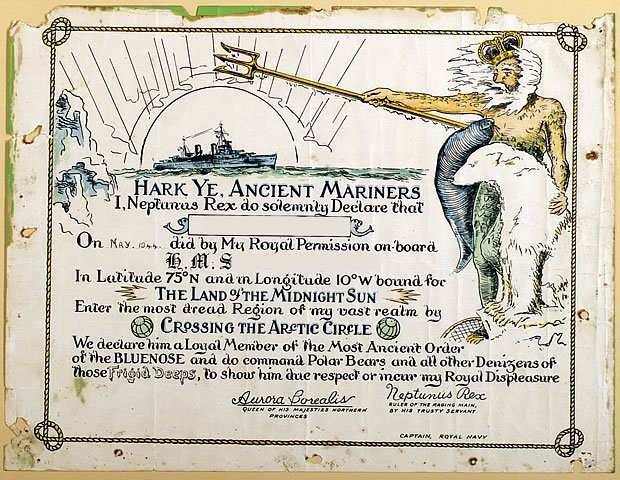 An unofficial 'Crossing the Arctic Circle [66° 33' 44" North latitude]
Certificate' ... received whilst serving as part of an Arctic convoy. In old
British Navy tradition, those receiving the Certificate were entitled to be
called a 'Loyal Member of the Most Ancient Order of the Bluenose'. Winston Churchill
called the Allied Arctic convoys to Russia between 1941 and 1945 “the worst
journey in the world”.
An unofficial 'Crossing the Arctic Circle [66° 33' 44" North latitude]
Certificate' ... received whilst serving as part of an Arctic convoy. In old
British Navy tradition, those receiving the Certificate were entitled to be
called a 'Loyal Member of the Most Ancient Order of the Bluenose'. Winston Churchill
called the Allied Arctic convoys to Russia between 1941 and 1945 “the worst
journey in the world”.
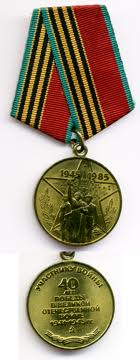 Mac received the 40th Anniversary 'Russian Convoy Medal' [1980's]
The awarding of Russian Medals to British veterans In the past, the Russian
Government has offered medals to British veterans to commemorate significant
anniversaries of the end of the Second World War. An approach was made to the
Foreign and Commonwealth Office (FCO) by the Russian authorities in the mid-1980s
when their 40th Anniversary of Victory in the Great Patriotic War Medal (also
known more commonly as the Russian Convoy Medal) was offered to British ex-Servicemen.
Originally instituted in 1985 and offered to British veterans shortly afterwards,
permission was not granted for it to be accepted and worn at that time. Some
years later, further official approaches by the Russians to the British Government
through the FCO were reconsidered. In 1994 The Queen granted permission for
this medal to be accepted and worn by eligible British citizens. This
was considered acceptable in the light of changed circumstances in Russia since
the medal was first issued, the improvement in relations between the United
Kingdom and the Russian Federation, and the fact that the medal was a commemorative
issue, recognising the passing of forty years since the end of the war, rather
than a foreign campaign medal. It was made clear at that time that it was not
envisaged that permission would be given for any future anniversary medals issued
by foreign or Commonwealth Governments to be accepted and worn by British citizens
where they related to services wholly rendered more than five years prior to
the proposal to make the award. Despite this, the Russian authorities made a
similar approach to the British Government in 1995 when they produced their
50th Anniversary of Victory commemorative medal. They were advised that permission
to receive and wear this medal would not be sought from The Queen as The Sovereign
does not recognise awards that commemorate an anniversary where permission has
already been granted to receive and wear an award for an earlier anniversary
of the same event. Following discussions we have had with our counterparts in
the FCO we can confirm that last year the Russian authorities approached them
with a formal request that their new 60th anniversary medal be awarded to British
veterans. As with the other Russian medals this is entirely a matter for the
FCO which is carefully deliberating the request, as are all similar requests
from foreign governments. Arctic veterans who did not apply for the Russian
Convoy Medal [the 40th anniversary medal] will be pleased to learn that the
Ministry of Defence Medal Office has located a small stock of medals which were
not sent out during the mid-Nineties. They will issue these on a first come,
first served basis to all those veterans who served on the convoys to Northern
Russia who had not previously applied for the medal. In common with other Russian
medals, the Russian Convoy Medal is not awarded posthumously. Please complete
the attached application form and send it to the medal office. You should bear
in mind that in view of the continued interest in medals, parcticularly since
the events last year to mark the 60th anniversary of the end of the Second World
War, there will be an unavoidable delay before any medals will be issued.
Mac received the 40th Anniversary 'Russian Convoy Medal' [1980's]
The awarding of Russian Medals to British veterans In the past, the Russian
Government has offered medals to British veterans to commemorate significant
anniversaries of the end of the Second World War. An approach was made to the
Foreign and Commonwealth Office (FCO) by the Russian authorities in the mid-1980s
when their 40th Anniversary of Victory in the Great Patriotic War Medal (also
known more commonly as the Russian Convoy Medal) was offered to British ex-Servicemen.
Originally instituted in 1985 and offered to British veterans shortly afterwards,
permission was not granted for it to be accepted and worn at that time. Some
years later, further official approaches by the Russians to the British Government
through the FCO were reconsidered. In 1994 The Queen granted permission for
this medal to be accepted and worn by eligible British citizens. This
was considered acceptable in the light of changed circumstances in Russia since
the medal was first issued, the improvement in relations between the United
Kingdom and the Russian Federation, and the fact that the medal was a commemorative
issue, recognising the passing of forty years since the end of the war, rather
than a foreign campaign medal. It was made clear at that time that it was not
envisaged that permission would be given for any future anniversary medals issued
by foreign or Commonwealth Governments to be accepted and worn by British citizens
where they related to services wholly rendered more than five years prior to
the proposal to make the award. Despite this, the Russian authorities made a
similar approach to the British Government in 1995 when they produced their
50th Anniversary of Victory commemorative medal. They were advised that permission
to receive and wear this medal would not be sought from The Queen as The Sovereign
does not recognise awards that commemorate an anniversary where permission has
already been granted to receive and wear an award for an earlier anniversary
of the same event. Following discussions we have had with our counterparts in
the FCO we can confirm that last year the Russian authorities approached them
with a formal request that their new 60th anniversary medal be awarded to British
veterans. As with the other Russian medals this is entirely a matter for the
FCO which is carefully deliberating the request, as are all similar requests
from foreign governments. Arctic veterans who did not apply for the Russian
Convoy Medal [the 40th anniversary medal] will be pleased to learn that the
Ministry of Defence Medal Office has located a small stock of medals which were
not sent out during the mid-Nineties. They will issue these on a first come,
first served basis to all those veterans who served on the convoys to Northern
Russia who had not previously applied for the medal. In common with other Russian
medals, the Russian Convoy Medal is not awarded posthumously. Please complete
the attached application form and send it to the medal office. You should bear
in mind that in view of the continued interest in medals, parcticularly since
the events last year to mark the 60th anniversary of the end of the Second World
War, there will be an unavoidable delay before any medals will be issued.
 Russian
Convoys Medal
Russian
Convoys Medal  Arctic Star Medal and
Pin
Arctic Star Medal and
Pin 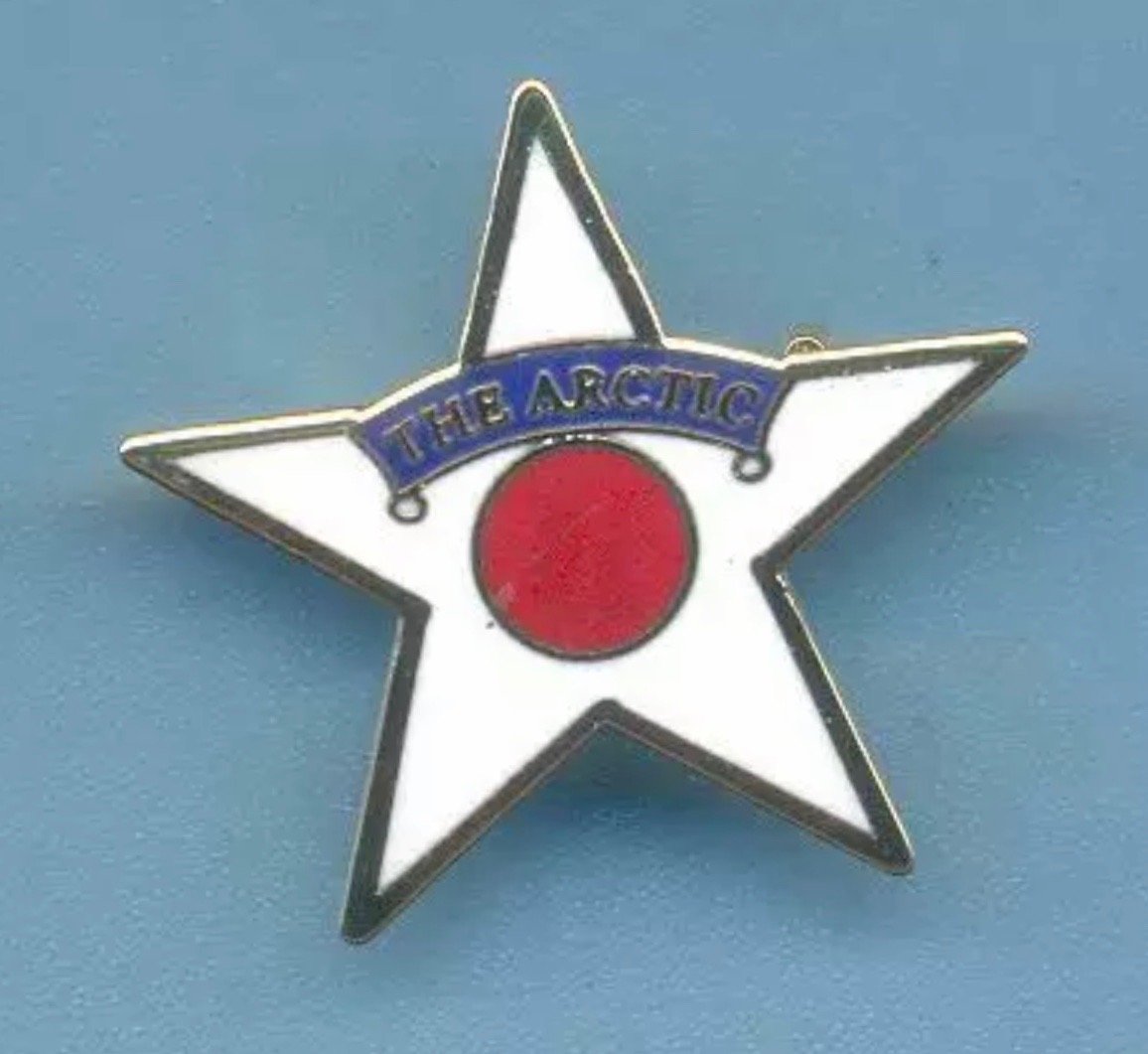
Arctic
Convoys Medal 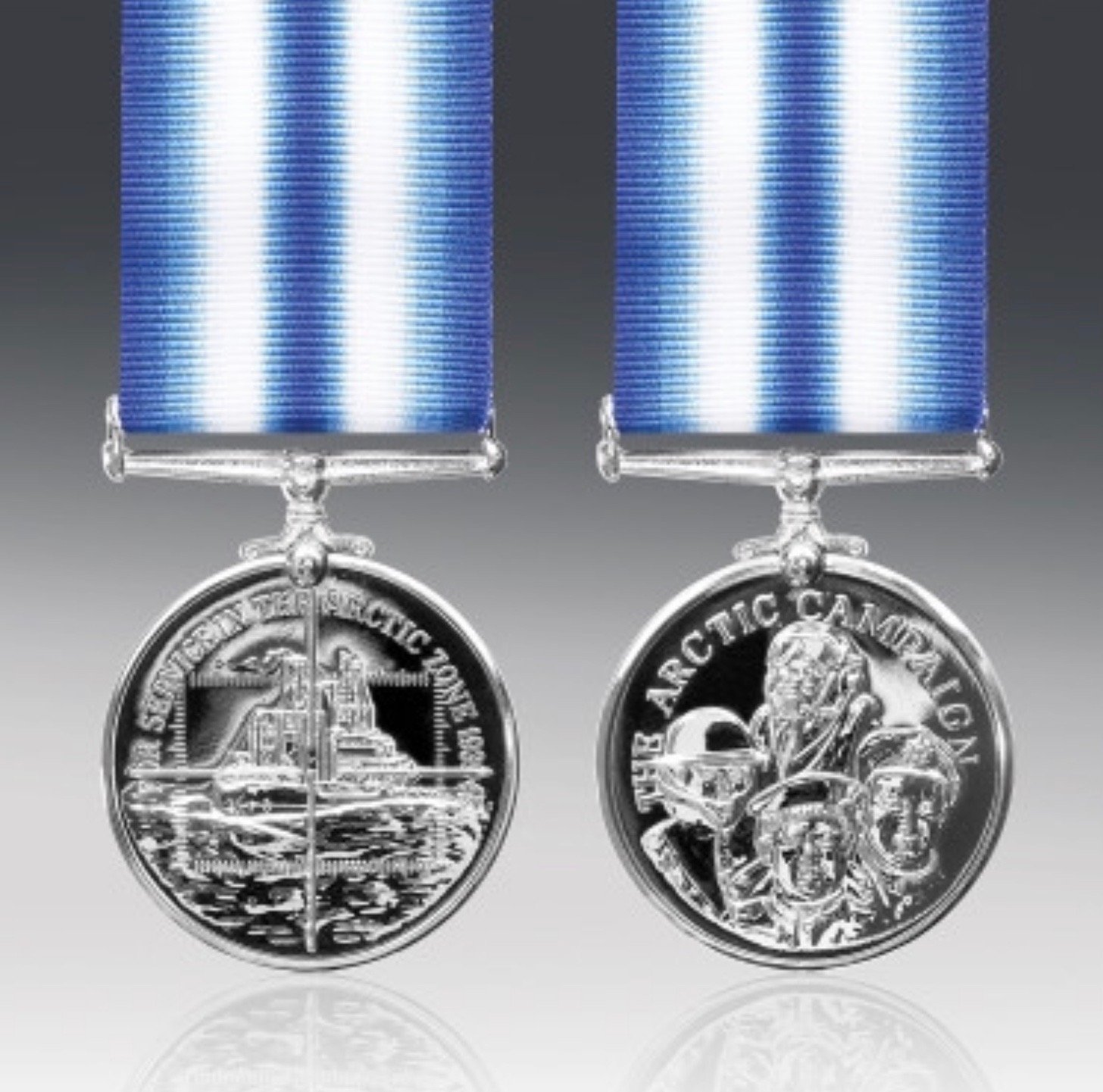
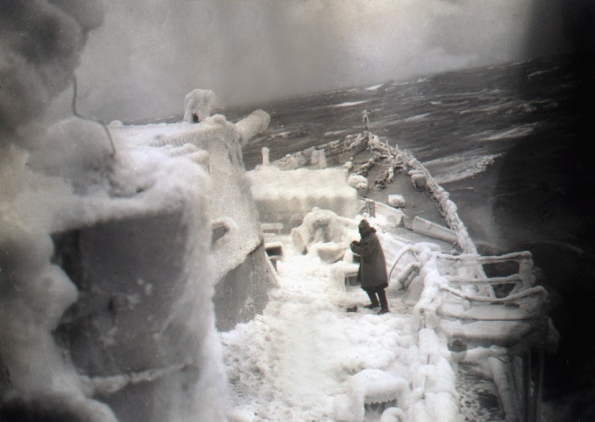
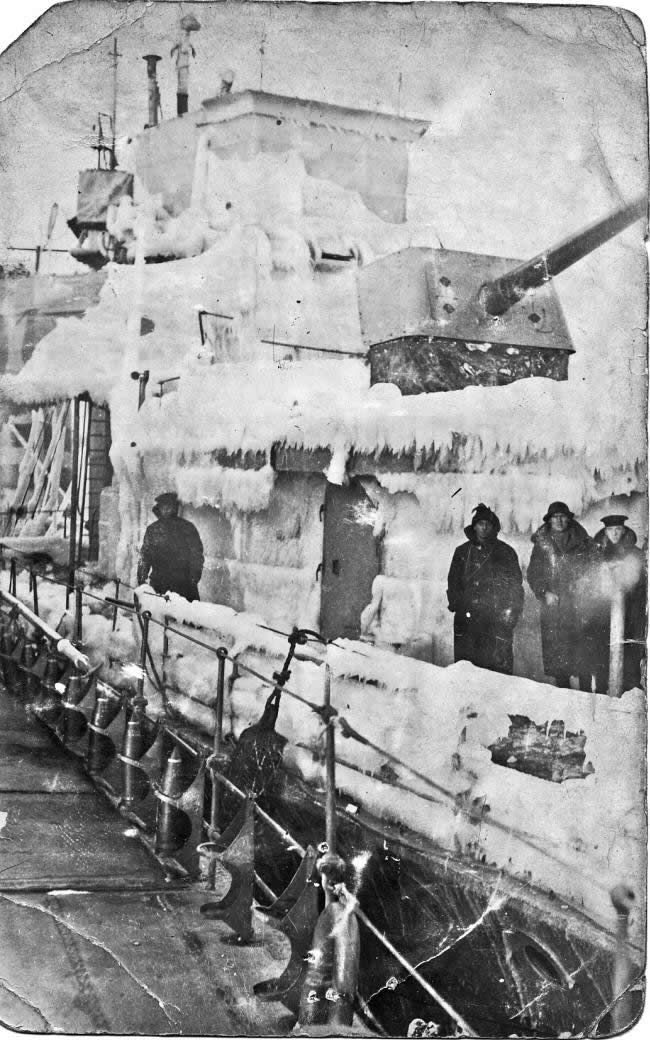
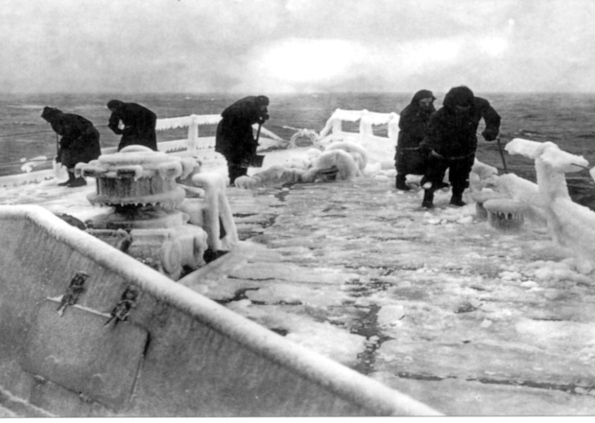
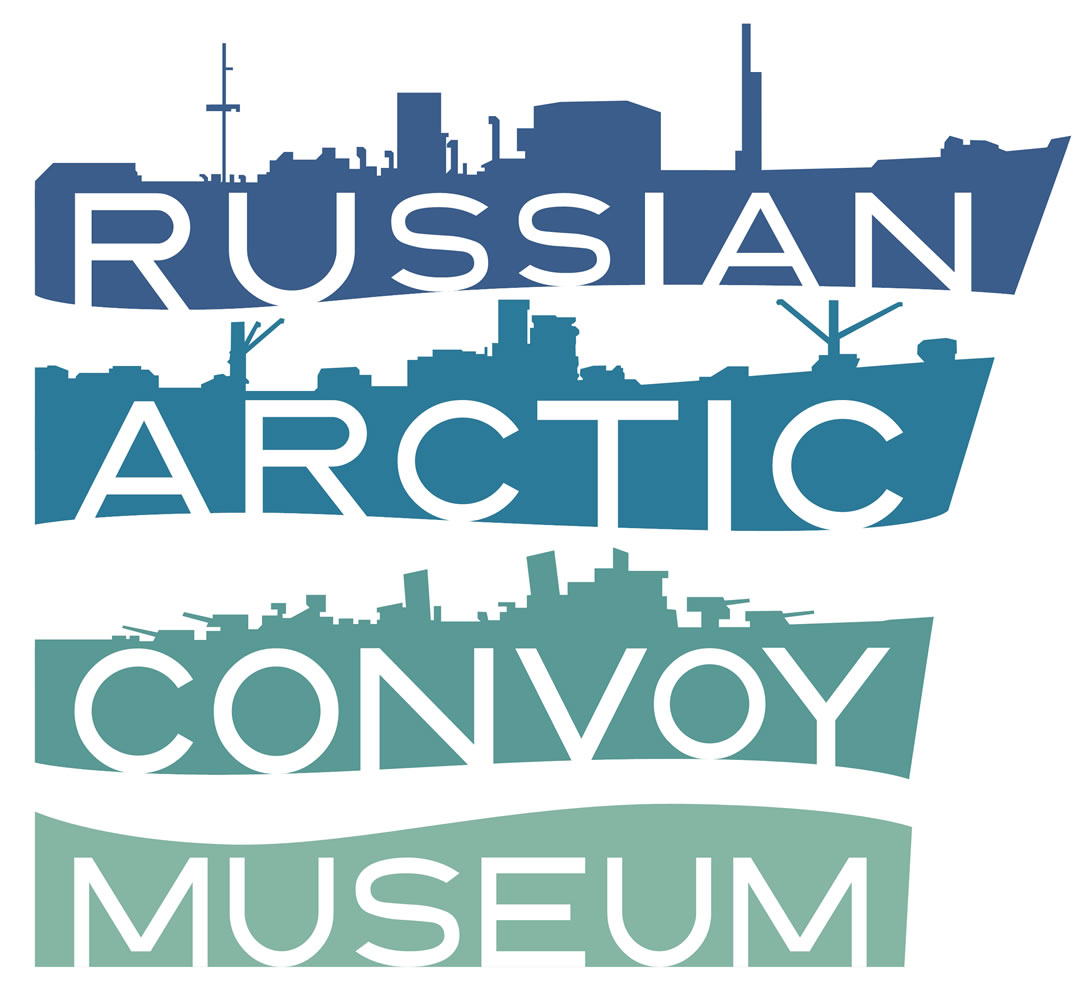
Russian Arctic Convoys Museum: The North Atlantic Fleet sailed from 1941 to 1945 from the UK to North Russian ports of Murmansk and Archangel to aid Russian Allies. The Russian Convoys, were called the Suicide Missions by many of those men who sailed on them. Merchant ships with supplies and ammunition were escorted by British Royal Naval ships and aircraft carriers. These supplies were vital to the war effort as German forces had Russia completely blockaded. During the war young men of 18 were drafted into the forces and some lads in the Merchant Navy were only 16 years old. With German u-boats and aircraft intent on stopping supplies to Russia many ships were lost and over 3,000 young men perished in the icy waters of the North Atlantic, their bodies never to be recovered. Supplies came initially solely from British sources with a greatly increasing quantity from America from January 1942. Allied supplies transported to Russia included 7,411 aircraft, 4,932 anti-tank guns and 5,218 tanks. For Prime Minister Winston Churchill, these supplies were a vital demonstration of Allied solidarity. He did however call the Arctic Convoys The Worst Journey in the World With a total of 78 Convoys to Russia, Loch Ewe in Wester Ross, Scotland was where 19 of the convoys departed, a further 23 left from Liverpool, The Clyde (Glasgow), Oban and Reykjavik (Iceland). From Russia to the UK there were 36 convoys.
On
30th March 1944: 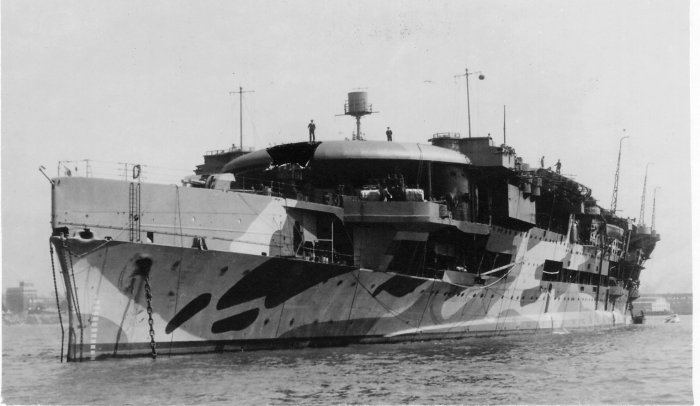 Squadrons 827, 829, 830 and Squadron 831 of 'HMS Victorious' and HMS Furious
[shown left] of the Home Fleet sailed from Hatston, Scapa Flow, in company with
a powerful force of battleships and escort carriers, in "Operation Tungsten"
[HMS Anson, Vice-Admiral Sir Henry Moore`s flagship; HMS Duke of York, HMS Emperor,
HMS Fencer, HMS Pursuer, and HMS Searcher, along with numerous cruisers and
destroyers].
Squadrons 827, 829, 830 and Squadron 831 of 'HMS Victorious' and HMS Furious
[shown left] of the Home Fleet sailed from Hatston, Scapa Flow, in company with
a powerful force of battleships and escort carriers, in "Operation Tungsten"
[HMS Anson, Vice-Admiral Sir Henry Moore`s flagship; HMS Duke of York, HMS Emperor,
HMS Fencer, HMS Pursuer, and HMS Searcher, along with numerous cruisers and
destroyers].
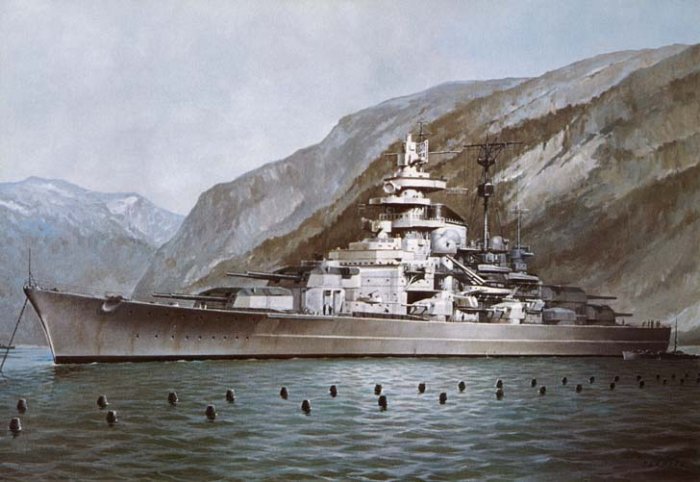 Their objective was to attack the superb and powerful German battleship Tirpitz
[see photos left and below], Germany's last surviving heavy surface unit, moored
in the supposedly impregnable anchorage of Altenfjord near Narvik in northern
Norway. Boom and net defences surrounded Tirpitz; she even had a smoke machine
on shore to create a smoke screen for cover, if she were attacked. Tirpitz was
about to leave harbour for trials so had to be stopped.
Their objective was to attack the superb and powerful German battleship Tirpitz
[see photos left and below], Germany's last surviving heavy surface unit, moored
in the supposedly impregnable anchorage of Altenfjord near Narvik in northern
Norway. Boom and net defences surrounded Tirpitz; she even had a smoke machine
on shore to create a smoke screen for cover, if she were attacked. Tirpitz was
about to leave harbour for trials so had to be stopped.
 Commissioned in 1941, the German Navy's mighty 42,900 ton Tirpitz posed a grave
threat to Allied shipping. Sister ship to the more famous Bismarck, the battleship
carried a main armament of eight 15 inch guns. She saw limited action, spending
her war career in Norwegian waters where just her presence was a constant danger
to Allied convoys bound for Russia, a presence that obliged the Allies to maintain
a large fleet in northern waters to guard against her. Commanded by KzS Hans
Karl MEYER, 24th February 1943 to 1st May 1944.
Commissioned in 1941, the German Navy's mighty 42,900 ton Tirpitz posed a grave
threat to Allied shipping. Sister ship to the more famous Bismarck, the battleship
carried a main armament of eight 15 inch guns. She saw limited action, spending
her war career in Norwegian waters where just her presence was a constant danger
to Allied convoys bound for Russia, a presence that obliged the Allies to maintain
a large fleet in northern waters to guard against her. Commanded by KzS Hans
Karl MEYER, 24th February 1943 to 1st May 1944.
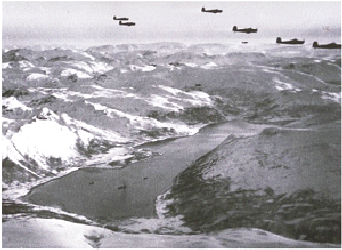 In the early hours of 3rd April, having approached to
within 120 miles of the Norwegian coast, the carriers launched 42 strike-bombers
and 80 fighters in two waves, three hours apart, in the largest air strike yet
undertaken by the Fleet Air Arm. 'HMS Victorious' had 50 aircraft aboard, some
stationed on deck as the hangar was full. Barracudas were equipped with special
1600lb armour piercing bombs to penetrate Tirpitz' deck.
In the early hours of 3rd April, having approached to
within 120 miles of the Norwegian coast, the carriers launched 42 strike-bombers
and 80 fighters in two waves, three hours apart, in the largest air strike yet
undertaken by the Fleet Air Arm. 'HMS Victorious' had 50 aircraft aboard, some
stationed on deck as the hangar was full. Barracudas were equipped with special
1600lb armour piercing bombs to penetrate Tirpitz' deck.
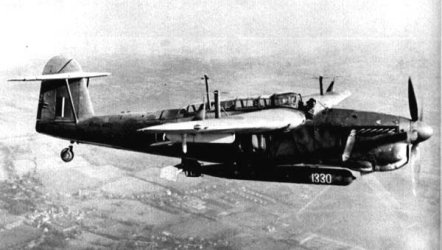 Barracuda II air attack from 'HMS Victorious' scored 14 hits
on the Tirpitz causing severe damage. Three Barracuda aircraft were lost
due to the intense enermy anti-aircraft fire. Tirpitz lay in Kaafjord and was
hit by 15 bombs and badly crippled, and although not sunk, was incapable of
putting to sea for several months during the crucial Normandy D-Day invasion
period of the Allies. In fact, the attack put Tirpitz out of action for three
months. Tirpitz was no longer a threat to allied merchant convoys. During the
operation, 'HMS Victorious' became the first Royal Navy aircraft carrier to
operationally use the F4U Corsair fighter. 'HMS Victorious' then returned victoriously
to Hatston, Scapa Flow, the Orkneys, arriving 6th April. She
was greeted with excited cheers and waves from every ship's crew anchored there.
There were messages of congratulations from King George VIth and Winston Churchill.
Victorious returned to Clyde, then to Scapa again the next month.
Barracuda II air attack from 'HMS Victorious' scored 14 hits
on the Tirpitz causing severe damage. Three Barracuda aircraft were lost
due to the intense enermy anti-aircraft fire. Tirpitz lay in Kaafjord and was
hit by 15 bombs and badly crippled, and although not sunk, was incapable of
putting to sea for several months during the crucial Normandy D-Day invasion
period of the Allies. In fact, the attack put Tirpitz out of action for three
months. Tirpitz was no longer a threat to allied merchant convoys. During the
operation, 'HMS Victorious' became the first Royal Navy aircraft carrier to
operationally use the F4U Corsair fighter. 'HMS Victorious' then returned victoriously
to Hatston, Scapa Flow, the Orkneys, arriving 6th April. She
was greeted with excited cheers and waves from every ship's crew anchored there.
There were messages of congratulations from King George VIth and Winston Churchill.
Victorious returned to Clyde, then to Scapa again the next month.
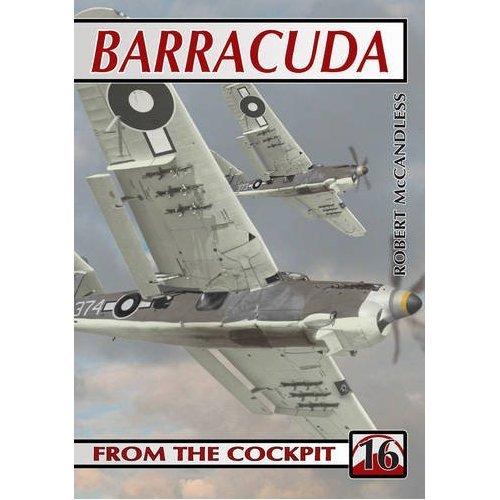 "Barracuda
- From The Cockpit" [Robert McCandless; Ad Hoc Publications]
"Barracuda
- From The Cockpit" [Robert McCandless; Ad Hoc Publications]
including photographic contributions from Mac Hartley. The most comprehensive book on the Barracuda, written by members of the Barracuda squadrons. "The Fairey Barracuda has traditionally received a mixed press, and there is no doubt that it gained something of a reputation for unexplained accidents when it first entered service, but it proved to be an important—if somewhat underpowered—component of the Fleet Air Arm’s inventory during World War II, and, once pilots had mastered the challenges of flying it, it came to be regarded as a rugged and reliable strike aircraft. It was widely employed throughout the fleet, seeing service more as a dive bomber than as a torpedo bomber, and it carried out valuable work in the second-line squadrons, especially in the anti-submarine rôle. It was not finally retired until mid-1953. This new book’s principal author, Lt-Cdr Robert McCandless, served on 827 [Barracuda] Squadron during the latter years of the war, taking part in the strikes against the German battleship Tirpitz and later flying from the carrier Colossus in the Far East. His incisive and detailed text is, as usual with this series of books, amplified by the recollections of others with first-hand memories of the Barracuda—pilots, observers and TAGs—throughout its operational career".
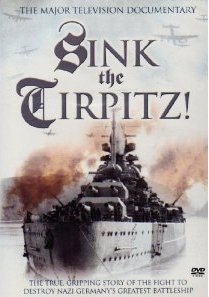 "Sink
The Tirpitz" [DVD:2006] and on YouTube ["Sinking
The Tirpitz" - Part One] ["Sinking
The Tirpitz" - Part Two] including footage of the Fleet Air attacks
on the Tirpitz in 1944.
"Sink
The Tirpitz" [DVD:2006] and on YouTube ["Sinking
The Tirpitz" - Part One] ["Sinking
The Tirpitz" - Part Two] including footage of the Fleet Air attacks
on the Tirpitz in 1944.
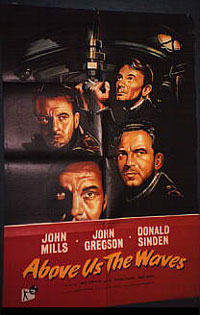 "Above Us The Waves" [1955] British film starring
John Mills tells of an attack on the 'Tirpitz' by Mini-Submarines in 1942.
"Above Us The Waves" [1955] British film starring
John Mills tells of an attack on the 'Tirpitz' by Mini-Submarines in 1942.
Early-April 1944: "Operation Hoops" [abandoned], later "Operation Ridge". HMS Victorious was involved in attacks against German troops, harbour installations and ships at Bodo and 150 miles north of Bodo, Norway. "80mph winds, snow storms, gales for a week ... no sleep !!" The ship returned to Scapa Flow.
24th
April 1944: "Operation Planet". 25th April, more attacks against
the Tirpitz [including HMS Fencer later replaced by HMS Striker] and against
other German ships; three were sunk, another two were damaged, for loss of six
Fleet aircraft. The flight deck pitched and tossed as Victorious was hit
by force nine gales. Visibilty was almost zero. Due to adverse weather, flying
conditions became impossible, and the task force retreated back to Scapa Flow.
During this time aircraft were involved in sinking four German submarines: U-277
sunk 1st May 1944 in the Arctic Ocean south-west of Bear Island, Norway, in
position 73º24'N, 15º32'E, by depth charges from a British Swordfish aircraft
[Squadron 842/C] from the British escort carrier HMS Fencer. 50 dead [all hands
lost]; U-959 sunk 2nd May 1944 in the Arctic Ocean north-west of Narvik,
in position 70º32'N, 04º37'E, by rockets from a Swordfish aircraft [Squadron
842, HMS Fencer]. 53 dead [all hands lost]; U-674 also sunk 2nd May 1944
south-east of Jan Mayen, in position 69º20'N, 00º20'W, by depth charges from
a British Swordfish aircraft, again of the escort carrier HMS Fencer [Squadron
842/K].49 dead [all hands lost].
On 8th May 1944 Field Marshall Montgomery came on board and addressed the crew.
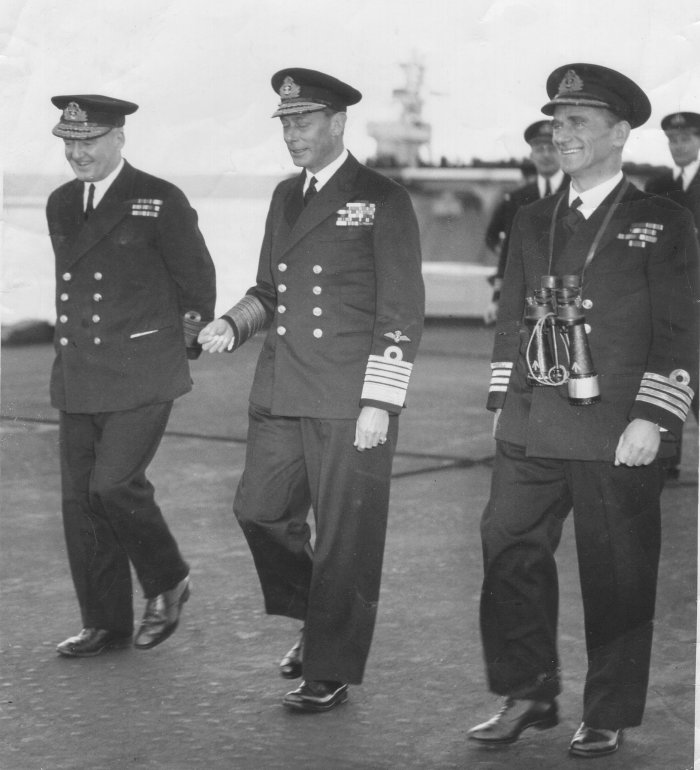 11th May 1944: visit by King George VIth, accompanied
by Admiral Fraser and Ship's Captain Denny ... getting ready for D-Day,
planned for June 6th. The King was aboard for several hours as the crew undertook
more Gunnery and Flying exercises.
11th May 1944: visit by King George VIth, accompanied
by Admiral Fraser and Ship's Captain Denny ... getting ready for D-Day,
planned for June 6th. The King was aboard for several hours as the crew undertook
more Gunnery and Flying exercises.
12th May: to sea again. 15th May 1944: "Operation Brawn". More attacks on the Tirpitz [HMS Victorious and HMS Furious only]. Bad weather once again returned to Scapa Flow, then back to Liverpool for more adjustments.
May 1944: "Operations Croquet, Hoops and Potluck". More attacks on shipping off the coast of Norway. Two German ships were sunk, another damaged.
28th May 1944: "Operation Tiger Claw". More attcks on the Tirpitz [HMS Victorious and HMS Furious, only: abandoned]
30th
May 1944: an unsuccessful torpedo attack against HMS Victorious by German
U-Boat U-957 "Good job she missed !!"
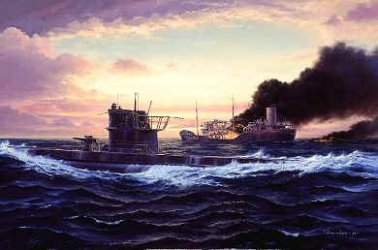 U-957 was a member
of the 11th Flotilla [front boat] based at Bergen, Norway. She was a 'V11C-41
[Atlantic]-type boat [the same as shown in the German film, 'Das Boot' [1981]]
and was produced at Blohm and Voss, Hamburg in 1942.
U-957 was a member
of the 11th Flotilla [front boat] based at Bergen, Norway. She was a 'V11C-41
[Atlantic]-type boat [the same as shown in the German film, 'Das Boot' [1981]]
and was produced at Blohm and Voss, Hamburg in 1942.
In May 1944 U-957 was on 29 days Arctic patrol out of Narvik [Wolfpack Trutz], Norway, during which time she attempted to torpedo HMS Victorious.
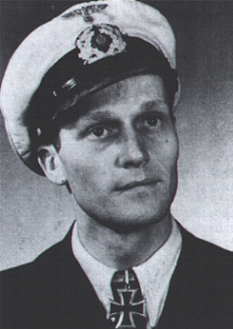 Her captain was Oberleutnant zur See 'Gerhard SCHAAR' [1919 at Berlin - 1983
at Maseru, Lesotho, South Africa]. Born in Berlin, Gehard later became Kapitänleutnant
and was decorated: Iron Cross [1st and 2nd], Narvik Shield, German Cross [Gold],
Knights Cross of the Iron Cross. Schaar won his Knights Cross for leading the
landing operation on the Soviet island Sterligova, where a radio station was
destroyed in September 1944. In all U-957 was responsible for 2 ships sunk for
a total of 7,564 tons [the British Fort Bellingham and the Soviet Nord] and
2 warships sunk for a total of 604 tons [the American submarine chaser USS PTC-38,
and the Soviet corvette Brilliant].
Her captain was Oberleutnant zur See 'Gerhard SCHAAR' [1919 at Berlin - 1983
at Maseru, Lesotho, South Africa]. Born in Berlin, Gehard later became Kapitänleutnant
and was decorated: Iron Cross [1st and 2nd], Narvik Shield, German Cross [Gold],
Knights Cross of the Iron Cross. Schaar won his Knights Cross for leading the
landing operation on the Soviet island Sterligova, where a radio station was
destroyed in September 1944. In all U-957 was responsible for 2 ships sunk for
a total of 7,564 tons [the British Fort Bellingham and the Soviet Nord] and
2 warships sunk for a total of 604 tons [the American submarine chaser USS PTC-38,
and the Soviet corvette Brilliant].
On 19 October 1944 at Lofoten, Norway U-957 had a collision with
a German steamer. On 21 October 1944 she was taken out of service in Trondheim.
On 29 May 1945 she was taken to England where she was broken up. In
April 1945 Schaar commissioned the Type XXI U-boat U-2551, which was scuttled
one month later.
On May 4th 1945 at 3.14pm, Reichspräsident and Supreme Commander of the German
Armed Forces, Grand Admiral Karl Donitz, broadcasted his final message; "You
have fought like lions. Unbeaten and unblemished, you lay down your arms after
a heroic battle without equal."
Early
June 1944: Deployed on shipping attacks off Norway "Operation Lombard".
1st June: Sank a minesweeper and a merchant ship.
'HMS Victorious' then sailed back to Liverpool, followed by training at Scapa
Flow.
HMS Furious had returned to operate as part of the Home Fleet, taking part in operations against Norway between January and September 1944. Notable operations at this time included her participation on all air strikes against the German Battleship Tirpitz in Northern Norway between April-June 1944 [including Operations Tungsten, Mascot and Goodwood]. She was decommissioned on 15th September 1944. She spent the last year of the war as an accommodation ship, and post-war she was used as an explosives target and trials ship from May 1945 til 1948. Sold for scrapping January 1948 and stripped at Dalmuir in March 1948, she was broken up at Troon from June 1948. Scrapping was only completed in 1954.

 Squadron
831 received Battle Honours: Atlantic Star Medal
Squadron
831 received Battle Honours: Atlantic Star Medal 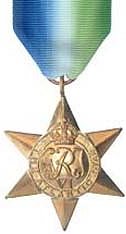
 Russian
Convoys Medal
Russian
Convoys Medal  Arctic Star Medal and
Pin
Arctic Star Medal and
Pin 
Arctic
Convoys Medal 
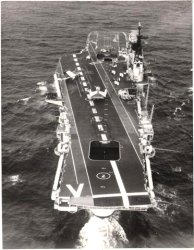 British Pacific Fleet: HMS Victorious 1944
British Pacific Fleet: HMS Victorious 1944
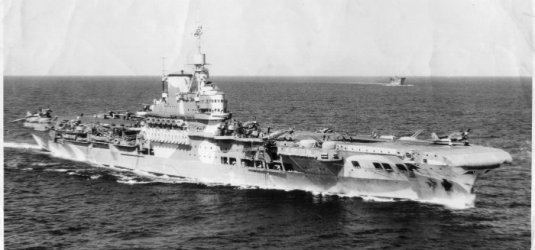
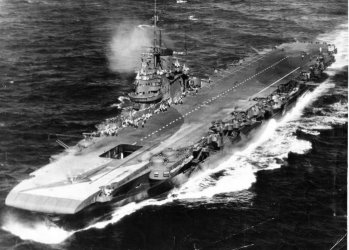
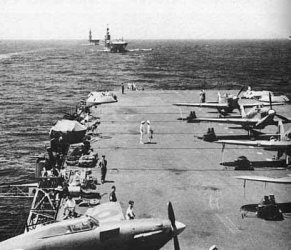 After operations in the North Atlantic, Squadrons 829 and 831 were merged
aboard HMS Victorious and transferred to the Pacific.
After operations in the North Atlantic, Squadrons 829 and 831 were merged
aboard HMS Victorious and transferred to the Pacific.
In total, over 2,000 sailors were on board, well over the ship's normal
accommodation limits; amongst the crew was Kenneth
More, later to be the most popular 1950's British Actor and had appeared
in a string of box office hits including Genevieve [1953], Doctor in the House
[1954], Reach for the Sky [1956] and A Night to Remember [1958]. Kenneth served
throughout the War in the Royal Naval Volunteer Reserve [RNVR]. He was demobbed
in 1946 as a Lieutenant, having served on the light-cruiser HMS Aurora as a
Watch Keeping Officer, and HMS Victorious as a Fighter Directions Officer.
8th June 1944, together with 'HMS Indomitable', 'HMS Victorious' left Greenock, sailed for Gibralta, then Algiers [18th June: the Casbar, narrow alleys and streets], passing Tunisia for Alexandria in Egypt [19th June: ashore by felucca, horse carriages everywhere], then Port Said [20th June] through the Suez Canal, into the Gulf, down the Red Sea [21st June] to Aden. "The heat here hit you. You couldn't breathe, sailors slept on deck, hammocks stretched between anything at hand, life jackets as pillows. Glad to get into the Indian Ocean. Prickly heat caused small very itchy water blisters over your body, eventually going away when you become used to the heat. Another annoyance was athletes foot. At Aden the 'bum boats' came alongside to sell fresh fruit".
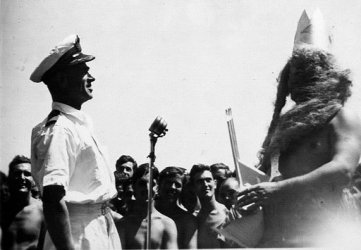 King Neptune and Captain meet on HMS Victorious - a photo of King Neptune and
the Captain M M Denning as they address each other during a "Crossing the
[Time] Line Ceremony" on board HMS Victorious in 1944.
King Neptune and Captain meet on HMS Victorious - a photo of King Neptune and
the Captain M M Denning as they address each other during a "Crossing the
[Time] Line Ceremony" on board HMS Victorious in 1944.
The ceremony of 'Crossing the Line' was a traditional initiation rite in the Royal Navy that commemorated a sailor's first crossing of the Equator. Originally, the tradition was created as a test for seasoned sailors to ensure their new shipmates were capable of handling long rough times at sea. The day before the ceremony was referred to as 'Wog Day' and sailors were called 'Wogs'. Sailors who had already crossed the Equator were nicknamed 'Trusty Shellbacks', often referred to as 'Sons of Neptune'. Those who had not were nicknamed 'Slimy Pollywogs'.
There were on board the ship a great number of officers and seamen, who had never yet gone South of the Tropics, consequently were to be initiated into the mysteries of crossing the Equinoctial line, and entering the dominions of Neptune; great preparations had been making since our leaving Woolwich, for an event which promised to some part of the crew great amusement, to the other great fear; many a poor girl at Woolwich, and at Spithead had been deprived of some part of her wardrobe, to adorn Amphitrite; from one a night cap and gown had been stolen, from another some other part of dress, and although I had no hand in it, I was as bad as the rest, for I was consenting thereto. An immense grey horse hair wig, sufficiently long to reach well down the back of Neptune, had been purchased in England by subscription, accompanied by a venerable grey beard to sweep his aged breast; a tin crown and a trident completed the regalia. On a review of all those who previously had crossed the line, I was selected as Neptune; in vain I endeavoured to defend myself from being deified, it was useless, I must be Neptune, all remonstrance was vain; I took it, resolved to use the trident with mildness. Now reader fancy to yourself the writer of these lines with his legs and arms well blacked, his cheeks, vermillion, short and very loose trowsers, a double frilled shirt, from whose ample folds the salt water dripped plentifully, two swabs for epaulets, a long grey horse hair wig, a venerable beard of the same colour, a tin crown, a trident, and to complete the whole, a hoarse church yard cough; fancy all this I say, and Neptune, or your humble servant in his shape stands before you. The evening before we expected to cross the line, the lookout man reported at 8, P.M., a light a head; presently a hoarse voice hailed "ship ahoy" which being answered by the Captain, Neptune intimated his intention to visit the ship early next morning. Accordingly early in the morning the ship was made snug, the top-sails were close reefed, courses hauled up, top gallant sails furled, a new sail was secured to the gunwale of the barge on the booms, the other edge to the hammock netting, leaving a hollow of eight feet, capable of containing an immense quantity of water; into this sail the very men who were to be dipped in it, were employed in pumping and bailing water, little thinking, poor creatures, they were making a rod for themselves. A gun had been dismounted on the forecastle, the carriage made into a car, on which were to sit Neptune and Amphitrite, and between them the Triton; in order to keep all secret, a sail was run across the forecastle to screen Neptune and his gang from observation. Just before the appointed time, all who were likely to undergo the dreadful operation of shaving were ordered below, the gratings put on, and a constable stationed to prevent the ascent of more than one at a time; a wise regulation, for our numbers were nearly equal, and had they shown fight, might have conquered; a rope was rove through a block on the main yard arm, to one end of which was secured a handspike, astride of which sat a man with his hands fastened to the rope over his head. ... The first of the ship's company that were shaved, who was brought up blindfolded by the whole posse of constables was the armourer, a weather-beaten honest old Hibernian, who had been a farrier in the Peninsular Army for many years. At the reduction, he had found his way as armourer of some small craft, and thence to our ship; on his entering for our ship, so anxious was he to be within the given age, which was thirty, that on being asked his age he gave it as eight and twenty, although fifty six was written in legible characters on his old cribbage face, which throughout the ship's company had gained him the cognomen of old eight and twenty. On this man then the barber had to perform his first functions; a bucket was filled with all the cleanings of the hen coops, pig-stys, &c. and with it a due proportion of tar had been mixed; with a large paint brush dipped in this villanous compound, and his razor, close to him the barber stood waiting the signal. My first question was "what is your name my man?" "John S----, your honour," at the instant of his opening his mouth the brush went across it, when the face the poor creature made it is impossible to describe, "phoo what do you call that?" "what do you call that?" I again asked the old man how old he was, "eight and twenty your honour, and so I am; oh I will spake no more, I will spake no more." As a last effort to make him open his mouth, I said if you mean to put him overboard, mind have a good rope round him for perhaps he cannot swim. Terrified at the idea of being thrown overboard the poor fellow said "I cannot swim, oh, I cannot swim;" but as the brush again crossed his mouth, he uttered with his teeth closed, "I will spake no more, by J---s I will spake no more if you drown me." Amid a roar of laughter two men tripped the handspike on which he sat and sent him backward into the sail where the bear was waiting to receive him; it was soon over, he escaped and stood by to see his shipmates share his fate. At the time of his being shaved he was not aware who Neptune was, when he found it out I could not get him to speak to me for some time; at length Irish good temper conquered, and we were friends again. [1825 by Royal Navy Petty Officer - John Bechervaise].
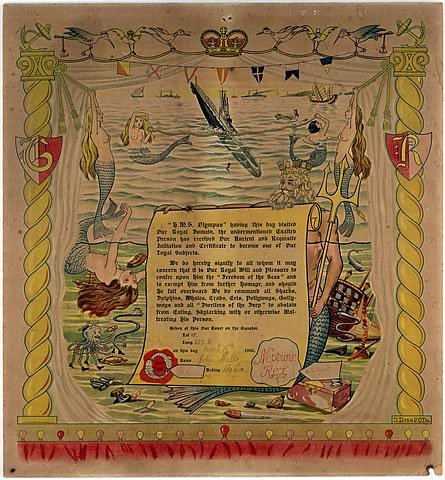 A Proclamation: Whereas by our Royal Consension, Our Trusty, Well Beloved ....................
has this day entered Our Domain. We do hereby declare to all whom it may concern
that it is Our Royal Will and Pleasure to confer upon him the Freedom of the
Seas without undue ceremony. Should he fall overboard, We do command that all
Sharks, Dolphins, Whales, Mermaids and other dwellers in the Deep are to abstain
from maltreating his person. And we further direct all Sailors, Soldiers, Airmen
and others who have not crossed Our Royal Domain, to treat him with the respect
due to One of Us. Given under Our Hand at Our Court on board H.M.S. ..............
on the Equator in Longitude .....° on this ..... day of ..... in the year .....
(Signed) Cancer — High Clerk Neptune — Rex.
A Proclamation: Whereas by our Royal Consension, Our Trusty, Well Beloved ....................
has this day entered Our Domain. We do hereby declare to all whom it may concern
that it is Our Royal Will and Pleasure to confer upon him the Freedom of the
Seas without undue ceremony. Should he fall overboard, We do command that all
Sharks, Dolphins, Whales, Mermaids and other dwellers in the Deep are to abstain
from maltreating his person. And we further direct all Sailors, Soldiers, Airmen
and others who have not crossed Our Royal Domain, to treat him with the respect
due to One of Us. Given under Our Hand at Our Court on board H.M.S. ..............
on the Equator in Longitude .....° on this ..... day of ..... in the year .....
(Signed) Cancer — High Clerk Neptune — Rex.
22nd June to 3rd July: escorted across the Indian Ocean to Bombay India [iced tea, beggars and prostitutes], then 4th July down to Colombo Ceylon to arrive 7th July [all day, bursts of monsoon rains, palm trees, coconuts].
 At Colombo for a refit ... and a 'jolly'. "Good Oh!" On to
Trincomalee by 19th July.
At Colombo for a refit ... and a 'jolly'. "Good Oh!" On to
Trincomalee by 19th July.
Barracudas
were based at Katukurunda, Ceylon [HMS Ukussa]. The main Naval Air Station base
for HMS Victorious was at Trincomalee, China Bay [HMS Bambara], where the US
were also based. Going ashore, a petty officer was waiting at the quayside,
told you to load your hammocks, kitbags and other gear on to a troopcarrier.
You climbed aboard another, and were driven through the streets, and soon came
onto rough sandy road with jungle either side. All around you were young, very
pretty native girls, big brown eyes, all topless, they'd smile at you. In the
troopcarrier the men are frantically shouting and wolf-whistling the girls until
the petty officer sitting beside the driver tells everyone to be quiet. The
bromide obviously isn't working !
In the morning you'd line up on the quarter deck with the 'Chief' facing you.
You'd stand at ease, wearing khaki shorts, shirts, long stockings, and white
hats. The gunnery officer would then let out a roar; “ Atten-tion !”, and in
the same breath, “Stand still !”.
The camp situation here was row upon row of long huts made from palm fronds
with a concrete base and no door or windows. Each hut contained at least forty
men with a bed and locker each. The heads [toilets] were situated outside at
the far end of the hut. No drain toilets here. There were eight dry closets
consisting of a wooden compartment with a pail, in cubicles with half doors.
Baths consisted of a concrete 'horse' trough. Showers were 'open air', fed from
a large tank of water supported on tall poles. They were operated by pulling
a chain. However the tanks would be full of frogs and terrapins so often the
shower would stop as the pipes became blocked. It was a lot easier to shower
in the mid-day rain ... the daily downpour would soak you to the skin in seconds.
Huts would constantly be invaded by wildlife; chipmunks, snakes, lizards, six-inch
long centipedes, bees the size of a tennis ball, and mosquitos, mosquitos, mosquitos,
everywhere, hence you had netting around your bed. You'd keep guns and machetes
handy for protection against wildlife ... and local native 'robbers'.
On entering the dining hall there was a fifty gallon barrel of ice cold lime
water which you are advised to drink, for the prevention of the dreaded disease
Scurvy [symptoms were painful and swollen legs, the flesh when pressed in would
not return to it’s former state. You suffer from bleeding, and extreme debility,
accompanied by swollen gums which prevents you from opening your mouth, your
breath smells and in the olden days you were lucky if you lasted a week. Then
it was the lack of fresh provisions]. Most meals would consist of a curry. Alcohol
would be local gin, beer and a strong toddy called 'arrack'', made from fermented
coconut sap and rice and tasting like a mixture of whisky and rum.
You'd fall in at the middle gate where a troopcarrier is waiting to take you
down to the airfield, where you'd work all day on aircraft. After a while you
were so brown you looked mahogany coloured. Pilots would practice 'dive bombing'.
They'd dive vertically from 10 000 feet down to 2 000 feet, in preparation for
bombing Japanese land bases. As well as carrying one torpedo, alternatively
Barracudas were capable of carrying three 500lb bombs.
Night came at about 1900 hours. Millions of fireflies and cicadas [crickets]
would descend to light up the darkness and blast out their 'calling songs'.
Evening entertainment would be held in the Village Hall, usually an ENSA show
or an old film.
The following week, more exercises with a squadron that hadn't been on
a carrier before."
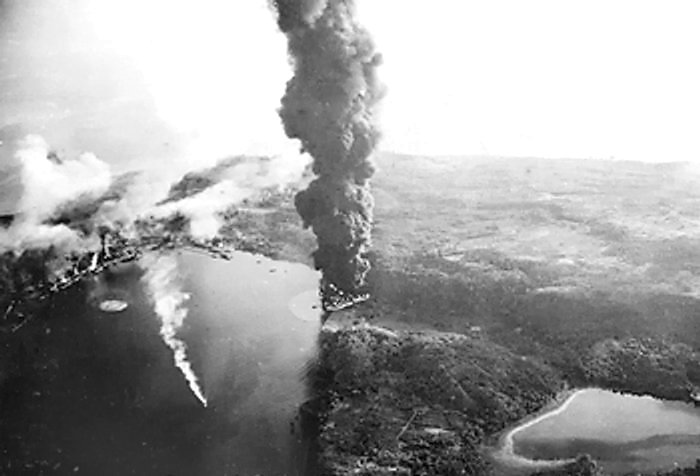 22nd July 1944: "Operation Crimson". Led strikes on Japanese
oil storage and airfields at Sabang harbour [Sumatra], the first time British
naval forces brought guns to bear [as opposed to air strikes] on Japanese shore
installations.
22nd July 1944: "Operation Crimson". Led strikes on Japanese
oil storage and airfields at Sabang harbour [Sumatra], the first time British
naval forces brought guns to bear [as opposed to air strikes] on Japanese shore
installations.
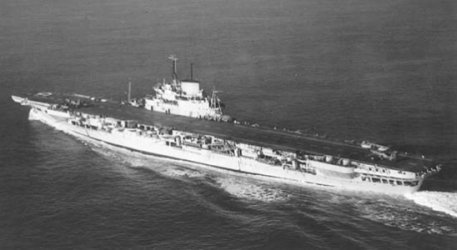 Strike against Palembang with HMS Illustrious [shown left] and escorted by HM
Cruiser Phoebe, then a strike against the Andaman Islands with HMS Indomitable,
. Admiral Lord Mountbatten, Supreme Allied Commander, South-East Asia, signalled,
“The results will hearten all forces in south-east Asia”. 25th July, back to
base.
Strike against Palembang with HMS Illustrious [shown left] and escorted by HM
Cruiser Phoebe, then a strike against the Andaman Islands with HMS Indomitable,
. Admiral Lord Mountbatten, Supreme Allied Commander, South-East Asia, signalled,
“The results will hearten all forces in south-east Asia”. 25th July, back to
base.
31st July: Noel Coward Concert on deck, followed by other ENSA concerts.

 Squadron 831 received Battle Honours: Burma Star Medal.
Squadron 831 received Battle Honours: Burma Star Medal. 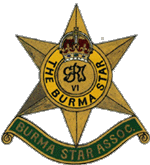
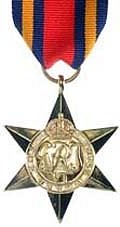
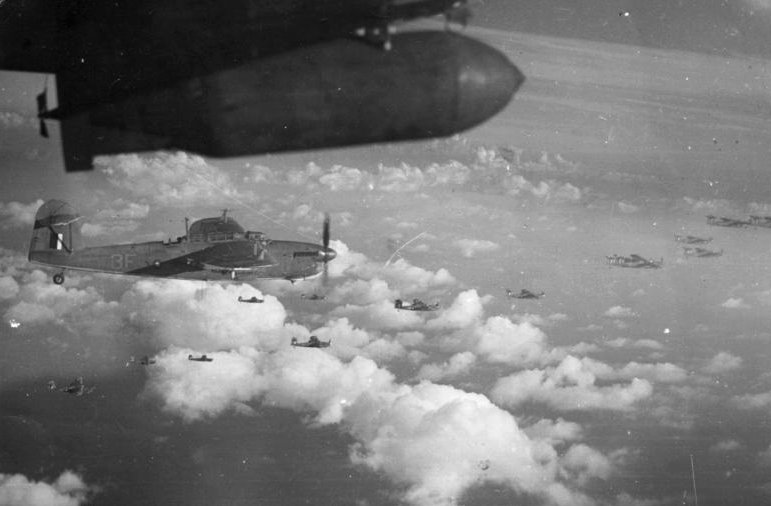 23rd and 24th August 1944: "Operation Boomerang" provided air-sea
rescue facilities during series of attacks by US Army aircraft on Sumatra
23rd and 24th August 1944: "Operation Boomerang" provided air-sea
rescue facilities during series of attacks by US Army aircraft on Sumatra
29th August "Operation Banquet". Strikes on cement works and airfield at Padang [Sumatra], Indaroeng and Emmahaven [Indonesia], with HMS Illustrious and HMS Indomitable, escorted by HMS Howe and Eastern Fleet units. Sailed back to Colombo.
September 1944: 2nd September: Mac attended HMS Ukussa at Katukurunda Ceylon for unspecified medical treatment.
14th
September: "Operation Light". Joined by HMS Indomitable, escorted
by HMS Howe. Raid, bomb and aerial photograph Madong, Nicobar Islands, and some
other ports in Northern Sumatra. Strikes on a Japanese railway repair yard
at Sigli, North Sumatra were carried out by 20 aircraft from each carrier.
Armourers would take bombs and torpedos from the carriers' magaine stores, wheel
them to the aircraft on trollies, then winch them up onto the aircraft after
being fused and detonators inserted. Ammunition belts were also inserted into
the guns on the wings. The aircraft hangars on board ship were very hot, smelt
of petrol, oil and aircraft dope. Aircraft made inadvertent attack on HM
Submarine Spirit, fortunately without causing any casualties. During this operations
steering problems were experienced.
18th September all raids completed and back again to Trincomalee,
Ceylon .
30th September: Serious steering problem has caused ship
to occasionally lose control. Back to Bombay for a week's repairs in dry dock.
"I hope we are going back home to England, soon, the heat is horrific,
tired of wiping off the sweat. Fed up with Foreign Service radio. Wish I could
go home for good and never come back to this hell hole".
October
1944: 6th October, sailed back to Colombo, then on to Trincomalee.
15th October "Operation Mullet". with HMS Indomitable,
escorted by H M Battlecruiser Renown. 17th to 20th October, strikes on the Nicobar
Islands, Nancowry Harbour [190 kilometers North West of Sumatra in the Bay of
Bengal] Four aircraft destroyed and five damaged during enemy air attacks. Further
steering problems arose. These raids were to divert the attention of the Japanese
from American landings on Leyte in the Philippines. Then back to Trincomalee
on 21st October.
22nd October 1944: Victorious was assigned to the British
Pacific Fleet, together with HMS Indominable, HMS Illustrious, HMS Implacable,
HMS Indefatigable and HMS Formidable. There were two battleships, HMS King George
V and HMS Howe.
HMS Victorious sailed for Colombo, then back to Bombay. Arrangements made for repair after HM Aircraft Carrier Illustrious arrived.
12th November 1944: Victorious was at Bombay for about one month for small repairs, dry dock, bottom scraped. The flying speed of Barracudas had been slowed down a lot by the tropical heat. It didn't help, either, that an order had come through to "cut three inches off each propella to prevent them from clipping the flight deck on landing" ... big mistake; the message had been intended for another aircraft, not the Barracuda ! Offically, however, it was "due to the poor performance of the Barracuda II aircraft in the tropical climate"; between 14th and 30th November 1944 the Squadron fitted spares, then flew all the Barracuda aircraft to stores located at Coimbatore, India. They were mothballed. The ship's crew went by train to Deolali, 190 miles NE of Bombay, for a well-earned rest. Camped under canvas with plenty of mosquito netting, crew were under constant threat by snakes and scorpions. Some rest ! More concert parties were organised to entertain. Eventually everyone went back to Bombay by train, then on to Colombo by 16th December.
December 1944: 'HMS Victorious' resumed operation duties. Not available for air strikes on oil refineries at Pangkalang by Eastern Fleet aircraft carriers. "Operation Robson".
With all Barracuda aircraft in storage, Squadron 831 was no longer required. The Squadron returned to the UK, firstly aboard HMS Battler and then were transferred to HMS Thane to Clyde Scotland, disbanding in late December 1944.
... MacH was safely returned to England.
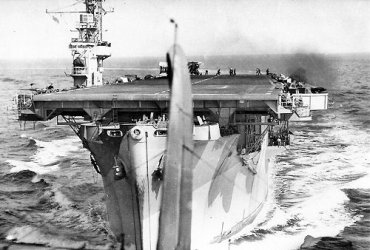 HMS Battler
HMS Battler 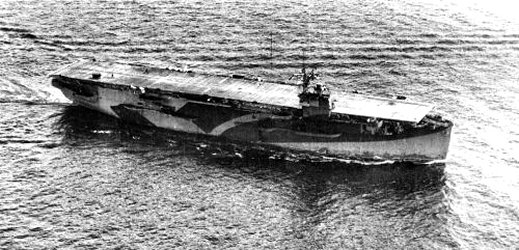 [formerly USS Altamaha] Transferred to the Royal Navy under lend-lease. Returned
to the United States Navy on 12 February 1946. Stricken by the United States
Navy on 28 March 1946. Sold to be broken up for scrap on 14 May 1946.
[formerly USS Altamaha] Transferred to the Royal Navy under lend-lease. Returned
to the United States Navy on 12 February 1946. Stricken by the United States
Navy on 28 March 1946. Sold to be broken up for scrap on 14 May 1946.
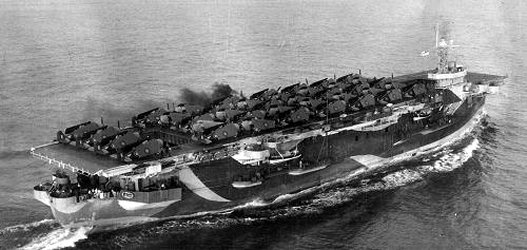 HMS Thane [formerly USS Sunset]. After returning to
the UK she operated in the North Atlantic protecting convoys and ferrying aircraft
for use in the European Theatre until she was torpedoed by U-1172 and severely
damaged on 15th January 1945 while in the Irish Sea but survived; was towed
to Greenock by HMS Loring, deemed beyond economical repair, declared a Constructive
Total Loss and put on reserve March 1945.. Returned to the United States Navy
on 15 December 1945. Stricken for disposal. Sold to be broken up for scrap.
Scrapped at Faslane in 1946.
HMS Thane [formerly USS Sunset]. After returning to
the UK she operated in the North Atlantic protecting convoys and ferrying aircraft
for use in the European Theatre until she was torpedoed by U-1172 and severely
damaged on 15th January 1945 while in the Irish Sea but survived; was towed
to Greenock by HMS Loring, deemed beyond economical repair, declared a Constructive
Total Loss and put on reserve March 1945.. Returned to the United States Navy
on 15 December 1945. Stricken for disposal. Sold to be broken up for scrap.
Scrapped at Faslane in 1946.
HMS Illustrious: after a refit in the UK from December 1943 to January 1944 she rejoined the Eastern Fleet in the Indian Ocean. Illustrious led strikes against Sabang in Sumatra in April 1944, Soerabaja on Java in May 1944, and Sabang in July 1944. Following a refit at Durban, South Africa between July to December 1944, she returned too the Eastern Fleet from December 1944 to January 1945, when she took part in air strikes against oilfields on Sumatra in December 1944, and Palembang in January 1945. From January 1945, Illustrious was assigned to the British Pacific Fleet, but first undertook repairs at Sydney, for removal of the central shaft between February - March 1945. Operations commenced again in March and again in April 1945, with air strikes against Sakishima Gunto and Formosa. On 9 April 1945, she received underwater damage from a Kamikaze attack, and was forced to undertake temporary repairs at Leyte, and further repairs in Sydney in May 1945, and repairs and alterations in the UK from June 1945 - June 1946. After the war she was involved in Home Fleet trails and duties as a training carrier 1946-54 during which time she took part in the initial deck-landing trials with jet aircraft. She was finally laid up in reserve in December 1954 and sold for scrap at Faslane 3rd November 1956
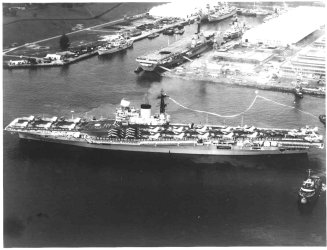 HMS Victorious
HMS Victorious 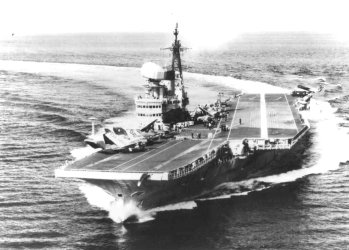
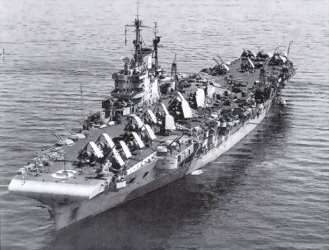
1945
- onwards. What happened to HMS Victorious? The British
Pacific Fleet finally departed Ceylon on 13 January 1945, en route to Sydney,
Australia. Aircraft from the fleet attacked installations on Sumatra and Java
on the 24th and 29th January [Operation Meridian]. In April 1945, Victorious
along with Illustrious, Indefatigable, and Indomitable, launched strikes against
Okinawa, along with the US 5th Fleet.
9th May 1945: HMS Victorious was hit by two Japanese Kamikaze
piloted aircraft, suffering only minor damage due to her armoured flight deck,
which was more resilent to such attacks than the wooden decks of American carriers.
While operating off Sakishima Gunto with TF 57, at 1657 hrs she was impacted
by a suicide plane, which struck alongside the island then skidded along the
deck and fell overboard. Its bomb exploded in the water and caused no damage.
At 1656 hrs another suicide crashed into the deck, blowing a hole of 2.3 m²
and causing a depression in the deck over an area of 13.3 m², with ancillary
damage to a bulkhead and a catapult. At 1657 hrs a third plane crashed to port
but caused no damage. There were 3 killed and 19 wounded from the 3 impacts,
Victorious was able to launch planes within 1 hour and land them 12 hours later,
being back in full action within 2 days. Full repairs required 1 month.
In July: aircraft from No. 849 Squadron, embarked aboard Victorious,
located and attacked the Japanese escort carrier Kaiyo, seriously damaging her
while at Beppu Bay, Kyu-shu-. She was stricken from the Japanese naval register
a few months later.
6th July: Sailed from British forward base at Manus for operations off
Japan. 16th Joined US Third Fleet ships 300 miles east of Japan.
17th July: Aircraft carried cut strikes on airfields in Tokyo area.
18th July: Air operations restricted by contamination in carrier petrol
refuelling supply system.
24th July: During air strikes on Osaka sank Ijn Kobe Class escort carrier
in Shido Bay.
9th August: Attacked airfields and shipping in North Honshu and Hokkaido.
12th August: Returned to Manus with TF37 and then took passage to Sydney.
[Withdrawal of British Pacific Fleet from operational area was due to the lack
of fuel from British sources. Only a Token force remained as part of US Third
Fleet. Sources report steering and machinery problems during service prior to
deployment in Pacific continued.]
31st August: Ships company took part in Victory Parade at Sydney.
Captain Michael Maynard DENNY CB CBE; 5th July 1945 promoted to Rear Admiral. October 1945 DSO. October 1948 promoted to Vice Admiral. June 1950 KCB. April 1952 promoted to Admiral. June 1954 GCB.
New Captain:
John Campbell ANNESLEY, DSO, RN 15th August 1945 – still in command in October
1945 according to the Navy List.
Final WWII light AA armament was 5 8-barrel 2 pound, 2 quad 40 mm, 2 dual 40
mm, 9 single 40 mm, 45 20 mm.
HMS Victorious served with the BPF until the end of war on repatriation duties
for former POW troops, 1945-47. Decommissioned to reserve January 1947 due to
lack of crew, but recommissioned as a harbour training ship October 1947. Designation
changed to R38 under NATO designation system. Extensively reconstructed as an
attack carrier at Portsmouth Dockyard starting March 1950; see postwar carriers
list for details. Recommissioned 14 Jan 1958. Refitted 1962-63 with 2 dual 3/50
and all 40 mm removed, flight deck strengthened and enlarged. Minor fire while
in refit November 1967; it was decided not to repair the damage and the ship
was decommissioned 13 March 1968 due to carrier force level cuts. Sold 1969
and scrapped at Faslane starting July 1969
* HMS Victorious Displacement: 35,500 tons full load Dimensions: 740 x 103.5
x 31 feet/225.5 x 21.5 x 9.5 meters Extreme Dimensions: 781 x 157 x 31 feet/238
x 47.9 x 9.5 meters Propulsion: Steam turbines, 6 boilers, 3 shafts, 110,000
shp, 31 knots Armor: 4 inch belt and hangar sides, 3 inch flight deck Crew:
2400 Armament: 6 dual 3/50, 6 40 mm Aircraft: 36 Concept/Program: A WWII-era
carrier completely rebuilt postwar to serve as an attack carrier. Plans to convert
two sisterships were cancelled due to their poor condition. Design/Conversion:
Complete reconstruction 1950-1958: totally gutted and stripped of all structure
down to hangar floor, hull widened, deepened and lengthened, machinery replaced,
hangar and angled flight deck rebuilt, new capapults fitted. Was an essentially
new ship following reconstruction. Modifications: Refitted 1962-63 with 2 dual
3/50 and all 40 mm removed, flight deck strengthened and enlarged. Departure
from Service/Disposal: Suffered minor fire while in refit 1968; it was decided
not to repair the damage and the ship was decommissioned due to carrier force
level cuts.
August 1945. "We were sitting in the canteen listening to the radio when the announcer cut in for a news flash. A Japanese city had been bombed by the Americans using an atom bomb. Tens of thousands of Japanese civilians and Korean POWs had been killed by just one massive explosion. The whole city had been destroyed, buildings, people, animals, almost everything. Days later came another atom bomb on another Japanese city. Six days after that the Japanese surrendered. The war in the Far East had ended."
Some of the places Mac had visited around the World ...

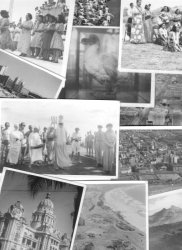
Norway, Gibralta, Algiers, Alexandria, Egypt, Suez, Aden, India, Ceylon, Sumatra, Indonesia
 Colombo, Ceylon
Colombo, Ceylon
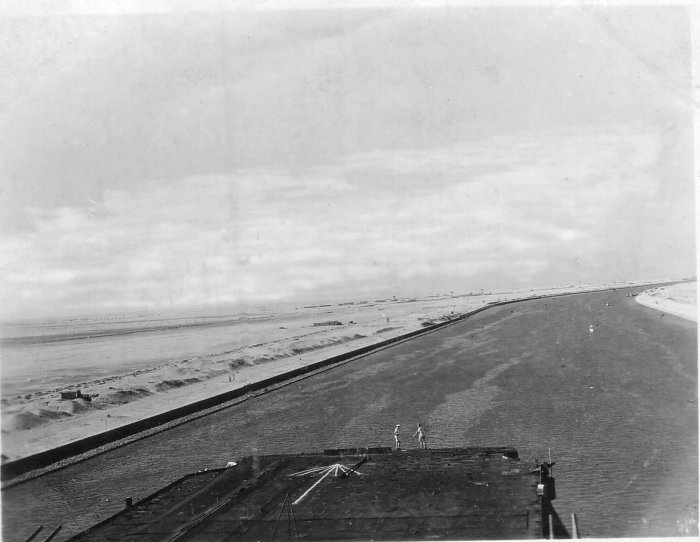 Passing through Suez Canal
Passing through Suez Canal 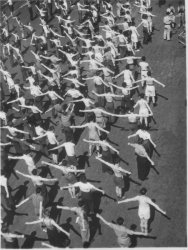 Deckercise
Deckercise
 Fleet Air Arm: May 1942 to April 1946
Fleet Air Arm: May 1942 to April 1946 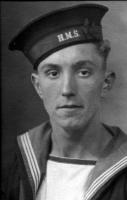






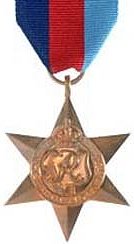
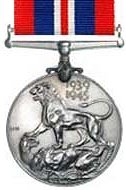
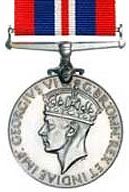




Squadron 831 Air Mechanics. "What Oh!". Mac's AMO mess mates ...
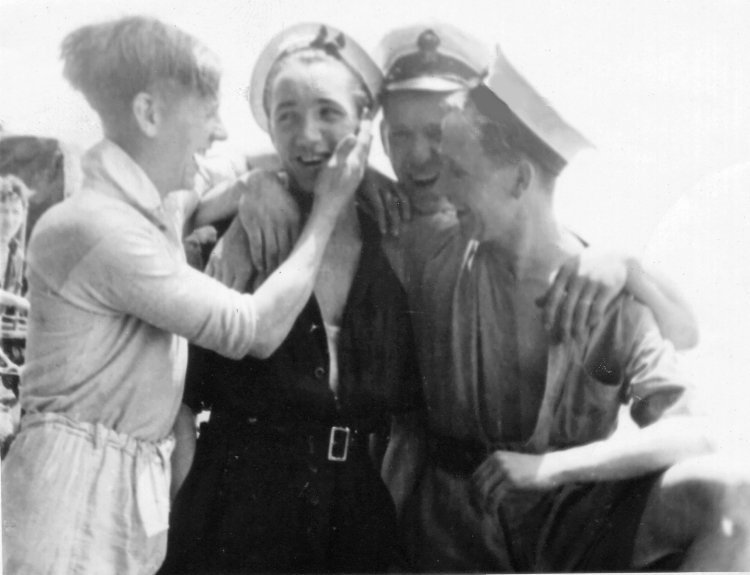 [left-right] Baldy, Poopdeck-Pape, officer, Brum.
[left-right] Baldy, Poopdeck-Pape, officer, Brum.
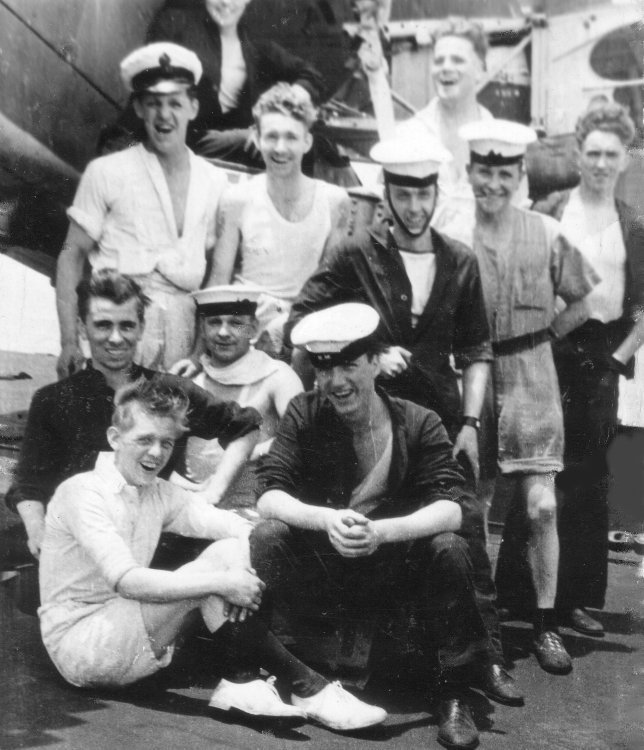 [top-standing] Sharp, Rich, Poopdeck-Pape, Jack, Wright, Brum, MacH. [bottom-sitting]
Tojo, Baldy, Taff, Sharp.
[top-standing] Sharp, Rich, Poopdeck-Pape, Jack, Wright, Brum, MacH. [bottom-sitting]
Tojo, Baldy, Taff, Sharp.
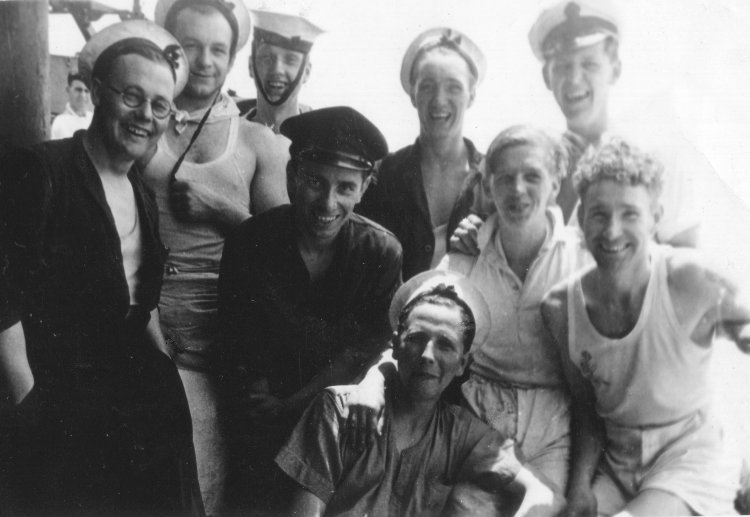 [left-right] Rich, Taff, Jack, Tojo, Brum, Sharp, Baldy, officer, Poopdeck-Pape.
[left-right] Rich, Taff, Jack, Tojo, Brum, Sharp, Baldy, officer, Poopdeck-Pape.
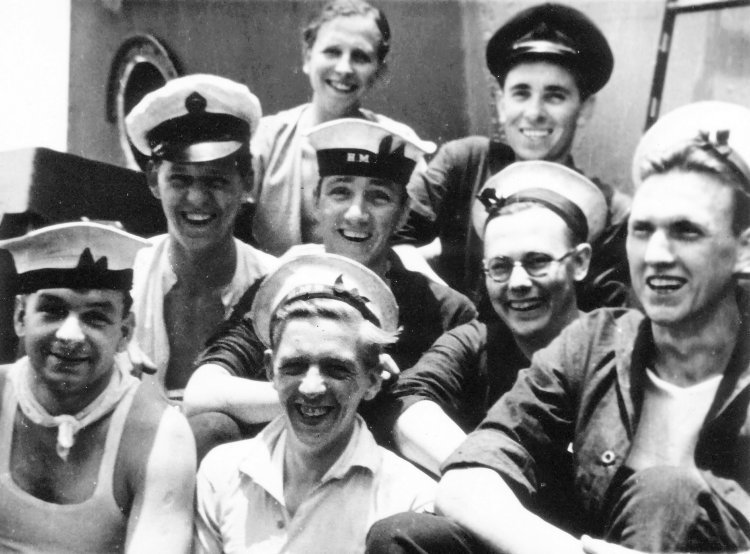 [top] female, Tojo [middle left-right] officer, Poopdeck-Pape, Rich.
[bottom left-right] Taff, Baldy, Brum.
[top] female, Tojo [middle left-right] officer, Poopdeck-Pape, Rich.
[bottom left-right] Taff, Baldy, Brum.
...
and finally, the Royal Naval Film Unit/Section. 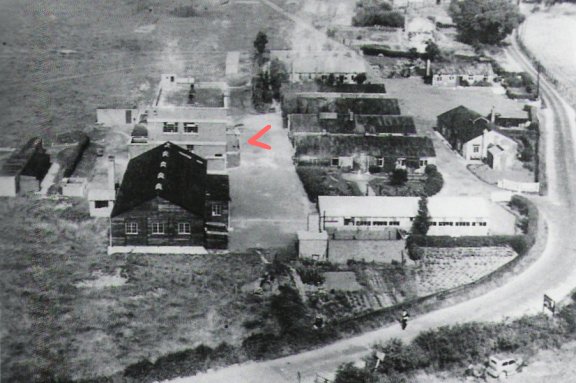 The Film Unit was based at HMS Excellence, Tipner, Portsmouth
[the building is identified by an arrow]
The Film Unit was based at HMS Excellence, Tipner, Portsmouth
[the building is identified by an arrow]
Do you know the names of anybody in the photo below ? I understand the following worked at the Royal Naval Instructional Film Unit ... Joe Henry MENDOZA [Leading Seaman], 'Puck' BISHOP [WRDutchNS], Hazel WILKINSON [WRNS, Editing Supervisor], Dora WRIGHT [Production Manager], Humphrey JENNINGS [Director], Gordon DINES [Cinematographer, Director], John Paddy CARSTAIRS [aka John KEYS][Film/TV Director], Paul BEESON, Clare TURNER, Captain Anthony KIMMINS [Director, Playwright, Screenwriter, Producer and Actor], Guy Vivian Arthur PHELIPS. Two camera crews, an animation section [Ken HARDY [Sergeant Petty Officer, later Sub-Lieutenant]. Most of the people who worked at the Film Unit had worked at Elstree Studios prior to the war. Several members went on to have successful careers in entertainment after the war.
MacH is in the photo, rear right, standing.
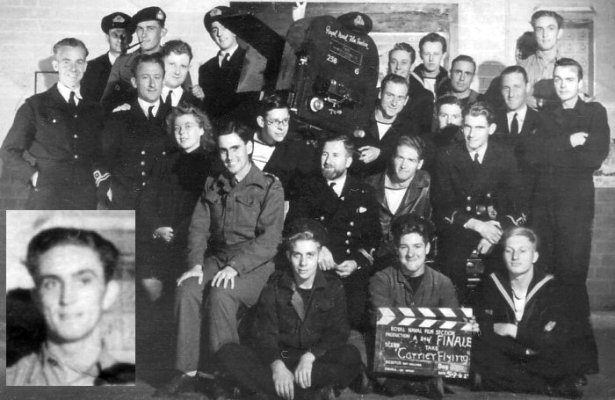
 The Royal Navy "Forties Navy - Flying Machines"
DVD features "Carrier Flying" shown on the clapperboard in the above
photo.
The Royal Navy "Forties Navy - Flying Machines"
DVD features "Carrier Flying" shown on the clapperboard in the above
photo.

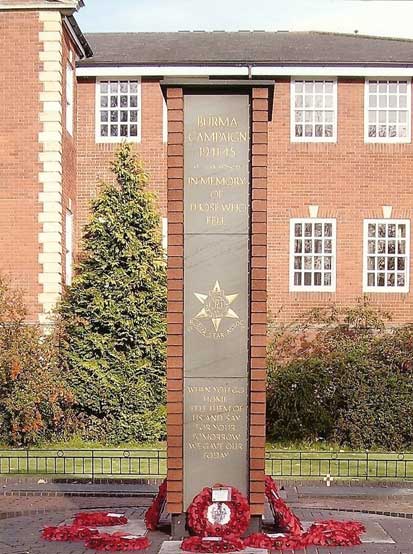
 Burma Star
Medal - awarded for service in the Burma Campaign between 1941 and 1945 for
service in China, Hong Kong, Malaya and Sumatra.
Burma Star
Medal - awarded for service in the Burma Campaign between 1941 and 1945 for
service in China, Hong Kong, Malaya and Sumatra.
 Atlantic Star Medal - awarded after the Battle of the Atlantic for service between
1939 and 1945 in the Atlantic, Home Waters, North Russia Convoys or South Atlantic
Waters.
Atlantic Star Medal - awarded after the Battle of the Atlantic for service between
1939 and 1945 in the Atlantic, Home Waters, North Russia Convoys or South Atlantic
Waters.
 1939-1945 Star Medal - awarded for service between 1939 and 1945.
1939-1945 Star Medal - awarded for service between 1939 and 1945.

 1939–1945 War Medal - awarded for service between 1939 and 1945.
1939–1945 War Medal - awarded for service between 1939 and 1945.



Place my body on a ship And burn it on the sea
Let my spirit rise Valkiries carry me
Take me to Valhalla Where my brothers wait for me
Fires burn into the sky My spirit will never die
The Life and Times of MacH ... 2024 ... Mac, the Family Man.
Welcome to WilliamHartley.UK
My Family Tree Research
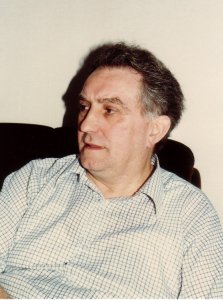
Father, Mac HARTLEY and macH2024

Paternal Grandfather, John William HARTLEY
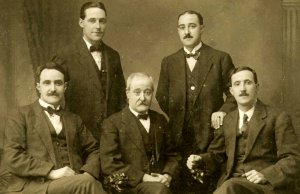
Paternal Great Grandfather, James HARTLEY, and his sons Richard, James, John William and Henry [Nathaniel deceased WWI]
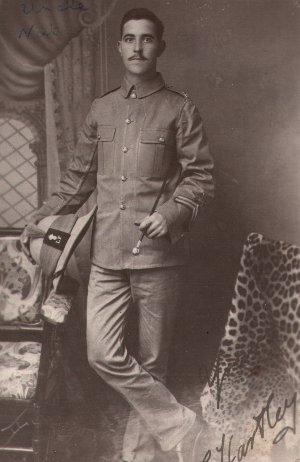
Paternal Great Uncle, Nathaniel HARTLEY
Mother, Joyce WILLIAMS

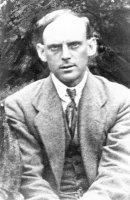
Maternal Grandfather, Henry Llech WILLIAMS
My Genetic Research Tree
please bookmark this website address: hartleyfamily.uk
Netvue Home and Business Security Wi-Fi Cameras
e-mail enquiries to: william@hartleyfamily.uk